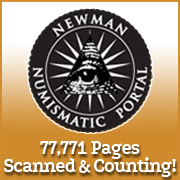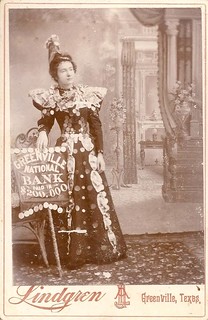
About UsThe Numismatic Bibliomania Society is a non-profit organization devoted to the study and enjoyment of numismatic literature. For more information please see our web site at coinbooks.org SubscriptionsThose wishing to become new E-Sylum subscribers (or wishing to Unsubscribe) can go to the following web page link MembershipThere is a membership application available on the web site Membership Application To join, print the application and return it with your check to the address printed on the application. Membership is only $20 to addresses in the U.S., $25 for First Class mail, and $30 elsewhere. For those without web access, write to: Terry White, Treasurer
AsylumFor Asylum mailing address changes and other membership questions, contact Terry at this email address: terrywhite5475@yahoo.com SubmissionsTo submit items for publication in The E-Sylum, just Reply to this message, or write to the Editor at this address: whomren@gmail.com BUY THE BOOK BEFORE THE COIN |
- WAYNE'S WORDS: THE E-SYLUM NOVEMBER 8, 2015
- DAVID SKLOW TO MANAGE ANA'S MANLEY LIBRARY
- NEW BOOK: WATERCRAFT ON WORLD COINS, VOL. III
- NEW BOOK: MODERN WORLD PAPER MONEY, 21ST ED
- BOOK REVIEW: STUDIES IN ANCIENT COINAGE IN HONOUR OF ANDREW BURNETT
- COIN COLLECTOR’S MANUAL: FIRST U.S. PRICE GUIDE
- QUERY: JACK FRIEDBERG PHOTO AND ROBERT FRIEDBERG SIGNATURE SOUGHT
- QUERY: 1997 SIGNED RED BOOK INFORMATION SOUGHT
- NOTES FROM E-SYLUM READERS: NOVEMBER 8, 2015
- MORE ON REMOVING PRICE STICKERS FROM BOOKS
- CONFRONTING THE LEGACY OF WALTER BREEN
- LUCK FOR MORSE COUNTERSTAMP
- A FIRST-RELEASE 1943 STEEL CENT ENVELOPE
- ARTICLE FEATURES SARATOGA QUARTER DESIGNER BARBARA FOX
- ARTICLE FEATURES RICHMOND DEALER JERRY SCHMIDT
- JAMES RIVINGTON (1724-1802)
- FINKELSTEIN ON DR. DAVID RITTENHOUSE – PART 3
- THE SOCIETY OF RATION TOKEN COLLECTORS
- SLIDESHOW: THE U.S. MINT IN DENVER, COLORADO
- WAYNE’S NUMISMATIC DIARY: NOVEMBER 8, 2015
- NOTES FROM LARRY GAYE
- THE MEXICAN-AMERICAN ‘DOLLAR,’ CIRCA 1877
- GOOGLE TRANSLATE GOOFS
- CENTS: TO SAVE OR NOT TO SAVE?
- IRELAND RETIRES 1- AND 2-CENT COINS
- GEORGIA ISSUES NEW BANKNOTES
- CAPE VERDE ISSUES NEW BANKNOTES
- RAINER FUCHS' ALTERED MYANMAR BANKNOTES
- MOVIE MONEY SPENT IN TENNESSEE
- THE SILVER DOLLAR DRESS OF GREENVILLE, TX
- NUMISMATIC AUCTIONS SALE #58 CLOSES NOVEMBER 30, 2015
- TRICK OR TREAT: COIN OR CANDY?
- ATM MAKER EXPERIMENTING WITH RETINA SCANNER
- FEATURED WEB SITE: CORPUS NUMMORUM THRACORUM
Click here to access the complete archive
To comment or submit articles, reply to whomren@gmail.com
WAYNE'S WORDS: THE E-SYLUM NOVEMBER 8, 2015

New subscribers this week include: Richard Bashein and Lee Hartz. Welcome aboard! We now have 1,892 subscribers.
This week we open with a note from the ANA, two new numismatic books, and one review. Other topics include the Coin Collector's Manual, Walter Breen, the Saratoga Quarter, Jerry Schmidt, James Rivington, and Movie Money.
To learn more about George F. Jones, the 1856 buzzard cent, Luck for Morse, ration tokens, the Denver Mint, the Mint Cabinet Account Books, Dick Yeo's original handmade mockup for the first Red Book, the silver dollar dress and the mystery of the upside-down treasurer, read on. Have a great week, everyone!
Wayne Homren
Editor, The E-Sylum
DAVID SKLOW TO MANAGE ANA'S MANLEY LIBRARY
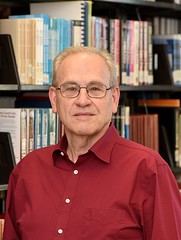 Renowned bibliophile David Sklow has joined the American Numismatic Association staff as the manager of the Dwight N. Manley Library. Sklow
will oversee and manage the library and its assets. During his previous employment, he served in a similar capacity as Director for the ANA Library
and Research Center, and was responsible for coordinating publications of the ANA Journal, a scholarly numismatic periodical. He has served as
the ANA Historian, a position he held for more than 11 years. Sklow continues to inspire junior collectors at the annual ANA Summer Seminar as the
Numismatic Literature instructor.
Renowned bibliophile David Sklow has joined the American Numismatic Association staff as the manager of the Dwight N. Manley Library. Sklow
will oversee and manage the library and its assets. During his previous employment, he served in a similar capacity as Director for the ANA Library
and Research Center, and was responsible for coordinating publications of the ANA Journal, a scholarly numismatic periodical. He has served as
the ANA Historian, a position he held for more than 11 years. Sklow continues to inspire junior collectors at the annual ANA Summer Seminar as the
Numismatic Literature instructor.
"It's great to be back, and moving forward," said David. "Books are the pathway to knowledge."
Involved in coin collecting for more than 50 years, Sklow started in the hobby as a casual collector but ultimately became a renowned historian, and an expert of numismatic literature.
Sklow holds a degree in applied Avionics from the Community College of the Air Force at Maryland, and is a graduate from the Eastern Military Academy, Cold Springs, New York. Upon graduation, he went on to serve as a Flight Engineer for the U.S. Air Force. With more than two decades of service in aviation, Sklow maintained and coordinated all in-flight systems, calculated the takeoff, in-flight and landing data, and oversaw emergency procedures.
His numismatic career took flight in 1992 when he opened Treasured Books. As owner, Sklow produced numismatic literature mail bid sales, and fixed price lists. In 1998 he became partner of The Money Tree, where he produced numismatic literature auction catalogs. Most recently, Sklow owned Fine Numismatic Books, a full service numismatic literature auction business.
An ANA life member, Sklow is a Charter and Life member of the Numismatic Bibliomania Society. His other memberships include the Numismatic Literary Guild, the Early American Coppers, and the American Philatelic Society. He is the past President for the Ocala Coin Club, and the former Secretary/Treasurer for the Token and Medal Society.
Sklow is a recipient of the Numismatic Ambassador Award, ANA Glenn Smedley Award, ANA Century Club Award, ANA Presidential Award, and the ANA Medal of Merit Award. He was awarded the Aaron Feldman Memorial Award for his first place exhibit displaying ANA Membership Directories in 2001.
The American Numismatic Association is a congressionally chartered nonprofit educational organization dedicated to encouraging people to study and collect money and related items. The ANA helps its 24,000-plus members and the public discover and explore the world of money through its vast array of education and outreach programs, as well as its museum, library, publications, conventions and seminars. For more information, call 719-632-2646 or go to www.money.org.
To read the complete press release, see:
American Numismatic Association Veteran Joins Staff :
David Sklow to Manage Dwight N. Manley Library (http://admin.listpilot.net/mpower/showHtml.do?ac=money&id=a0x4mgp_30a9a16c)
To read the earlier E-Sylum article, see:
DAVID SKLOW BECOMES ANA LIBRARY MANAGER
(www.coinbooks.org/esylum_v18n44a05.html)

NEW BOOK: WATERCRAFT ON WORLD COINS, VOL. III
 Watercraft on World Coins is a three-volume catalog that narrates all modern "ship coins" issued from 1800. The first
volume (287 pages, published in 2007) includes the coins issued by European countries up to and including 2005; the second volume (359 pages,
published in 2010) presents the coins of nations in the Americas and Asia until 2008; Volume III (460 pages, available in the United States early
2016) narrates the coins of countries in Africa and Oceania to 2011.
Watercraft on World Coins is a three-volume catalog that narrates all modern "ship coins" issued from 1800. The first
volume (287 pages, published in 2007) includes the coins issued by European countries up to and including 2005; the second volume (359 pages,
published in 2010) presents the coins of nations in the Americas and Asia until 2008; Volume III (460 pages, available in the United States early
2016) narrates the coins of countries in Africa and Oceania to 2011.
Within each continent, the coins are arranged alphabetically per country, and within each country they are presented according to the sequence of their KM-numbers. This arrangement facilitates looking up current values of the coins in the latest edition of Krause Mishler's Standard Catalog of World Coins. It is interesting to note, however, that 22% of the designs narrated in the new volume are not yet listed in the Standard Catalog.
Within a country, all coins with a common ship design are grouped under one heading. This applies, for example, to South African pennies and halfpennies, with legends in English or Afrikaans, which were issued by different British monarchs prior to independence. All of them depict the flagship of the Dutchman who established the trading and victualing station at the Cape of Good Hope that grew into the city of Cape Town. A general catalog treats all these coins as different types, while for a topical collector they constitute just one type. He or she can decide to collect all the coins grouped together or just one of the type.
Black-and-white illustrations are presented in the catalog for about 80 per cent of the designs. The illustrations are all crown sized, most of them having been enlarged so that the designs appear to full advantage. The actual diameter of the coin is stated near the image.
Each listing is followed by a narrative, commencing with a detailed description of the design beyond the basics such as the country name and denomination. The side of the coin that depicts the watercraft is presented first.
The description is followed by vital statistics of the ship, her history and her fate; background information about the persons depicted and their relevance to the ship; and particulars about the event commemorated by the coin. Other aspects of the design, such as bridges, buildings, aircraft, masks, and sculptures shown on the coins, are described as well, and the edge inscription is stated. Where available, the painting or lithograph is named after which the design was modeled.
These narratives, often more than 400 words long, are what sets the book apart from other catalogs and makes the book attractive to the collector who wants to understand the design of the coin and its historical relevance. I am not aware of any other catalog that goes into so much detail when describing a coin.
Finding all such information has been a challenge, even in this age of Internet, text and image search machines, and translation tools. Information found in press releases by the central banks and mints that market the coins, or in numismatic periodicals in English, German, and Dutch, is limited and had to be supplemented by research in specialized libraries, creative thinking, and assistance by persons in countries far away, such as a ship coin collector in Russia or a ship stamp collector in New Zealand.
While I have researched ship coins for forty years, writing of the book began when I retired at the age of 65. Now at the age of 81 I feel very fortunate to have been able to bring this work to fruition and I am happy to share the results of my research with fellow numisnautists and other interested collectors.
Ship coins are one of the most popular collecting themes. No wonder that mints flood the market with new issues. To illustrate the volume of new issues: of the 955 designs narrated in the third volume, 35% relate to issues of the last 6 years (2006-2011). The remaining 65% relate to issues of the preceding 206 years (1800-2005).
The book is published in England by The Alpha Press. Their web page for the book is http://www.sussex-academic.com/sa/titles/alpha_press/dotan.htm. The page includes reviews for the first two volumes and presents a Google preview of some of the pages of the book. Volume III has 460 pages and 770 coin images. The list price is $79.95 and the ISBN 978-1-898595-51-9.
I hope that fellow ship coin collectors will enjoy this unique source of knowledge to enhance their collecting experience. And after taking the book in hand, other readers as well may be attracted to this fascinating subject and start their own collection of ship coins.
To read the earlier E-Sylum articles, see:
REVIEW: WATERCRAFT ON WORLD COINS, VOLUME I BY YOSSI DOTAN
(www.coinbooks.org/esylum_v10n45a05.html)
BOOK REVIEW: DOTAN, WATERCRAFT ON WORLD COINS VOLUME II
(www.coinbooks.org/esylum_v13n38a06.html)
NEW BOOK: MODERN WORLD PAPER MONEY, 21ST ED
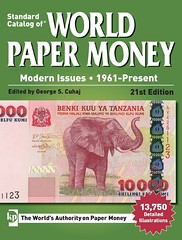 Standard Catalog of World Paper Money, Modern Issues, 1961-Present, 21st Edition
Standard Catalog of World Paper Money, Modern Issues, 1961-Present, 21st Edition
By George S. Cuhaj
Format: Paperback
A network of more than 80 international paper money collectors and dealers work with editor, George S. Cuhaj, to ensure that the Standard Catalog of World Paper Money, Modern Issues, is the most comprehensive resource available for proper identification, description and valuation of modern world bank notes. All circulating paper bank notes worldwide are included in this one-of-a-kind catalog. This brand-new 21st edition includes 30,000 adjusted prices, enhanced descriptions, and more information on specific design elements throughout the catalog.
The 21st edition of the Standard Catalog of World Paper Money includes:
- Valuable data added by 80 international paper money collectors and dealers
- Hundreds of new world mint issues
- Hundreds of new and improved images for easy identification
- In-depth descriptions for accurate identification
SKU T6740
Author/Speaker/Editor George S. Cuhaj
Format Paperback
ISBN 13 9781440244117
Number Of Pages 1216
For more information, or to order, see:
Standard Catalog of
World Paper Money, Modern Issues, 1961-Present, 21st Edition
(www.shopnumismaster.com/standard-catalog-of-world-paper-money-modern-issues-1961-present-21st-edition)
BOOK REVIEW: STUDIES IN ANCIENT COINAGE IN HONOUR OF ANDREW BURNETT
 It takes a lot of courage – or should we say
audacity – to initiate a work as huge as the catalog of Roman Provincial Coinage. Most of all, however, it takes an unlimited network of
friendly colleagues who are willing to contribute to such an ambitious project. Anyone who wants to undertake such a project needs amicable
relations to many numismatists. Andrew Burnett is such a person. A modest personality, quite popular with colleagues, he had the foresight
of starting to prepare a catalog of all coins produced in the Roman provinces.
It takes a lot of courage – or should we say
audacity – to initiate a work as huge as the catalog of Roman Provincial Coinage. Most of all, however, it takes an unlimited network of
friendly colleagues who are willing to contribute to such an ambitious project. Anyone who wants to undertake such a project needs amicable
relations to many numismatists. Andrew Burnett is such a person. A modest personality, quite popular with colleagues, he had the foresight
of starting to prepare a catalog of all coins produced in the Roman provinces.
Now what has this got to do with his festschrift? Very simple. His amicable relations to the most distinguished numismatists of our time are reflected in the list of authors who insisted on contributing to this volume with an essay and thus honoring their dear friend. The names speak for themselves and bear witness to the quality of this festschrift. To provide you with the opportunity to see for yourself how wide the range of topics really is, we reproduce the list of contents here:
- Johan van Heesch and Fran Stroobants, The silver coinage of Sagalassos in Pisidia;
- Giovanni Gorini, A new hoard of Romano-Campanian coins from Nora (Sardinia);
- Michael Crawford, The coinage of the Mamertini;
- Pere Pau Ripollès and Richard Witschonke, The unofficial Roman Republican semisses struck in Spain;
- Ian Leins, Anarevito: Political fluidity in southern Britain in the late Iron Age;
- Michel Amandry, Une mystérieuse émission provinciale tibérienne frappée en Asie Mineure;
- Chris Howgego, The circulation of the gold coinage of Vespasian struck in the East;
- William E. Metcalf, A new Vespasianic mint?;
- Richard Abdy, Capita aut capita? The double heads (and double tails) coins of Hadrian;
- Richard Reece, Coins and sites: cautionary tales from Time Team;
- Roger Bland, Roman contacts with Ireland in the light of the coins from Drumanagh;
- Kevin Butcher, Debasement and the decline of Rome;
- Dario Calomino, From Thrace to Lesbos. Coinage and cities across the Hellespont in the 3rd century AD;
- Jerome Mairat and Antony Hostein, Les monnaies d’Alexandrie de Troade au milieu du IIIe siècle: liaisons de coins indédites;
- Alexander Bursche und Kirill Myzgin, Gold coins, Alexandria Troas and Goths;
- Sylviane Estiot, L’Empereur et l’usurpateur: un 4e atelier oriental sous Probus;
- Sam Moorhead, A dated coin of Allectus; Edward Besly, Allectus and his money;
- Francois de Callatay, Sir Andrew Fountaine (1676-1753) and his early numismatic correspondence with Andreas Morell (1646-1703).
Roger Bland and Dario Calomino (eds.), Studies in Ancient Coinage in Honor of Andrew Burnett. London 2015, Spink. 316 p. with numerous b/w illustrations. Hardcover with elaborate dust jacket. Adhesive binding. 21.5 x 28 cm. ISBN 978-1-907427-57-2. 50 pounds + postage and packaging.
For more information or to order, see:
Studies in Ancient Coinage in Honor of Andrew Burnett by Bland, R. and Calomino,
D. (eds.) (www.spinkbooks.com/product.php?xProd=547)
To read the complete article, see:
Studies in Ancient Coinage in Honour of Andrew Burnett
(http://coinsweekly.com/en/News/4?&id=3737)
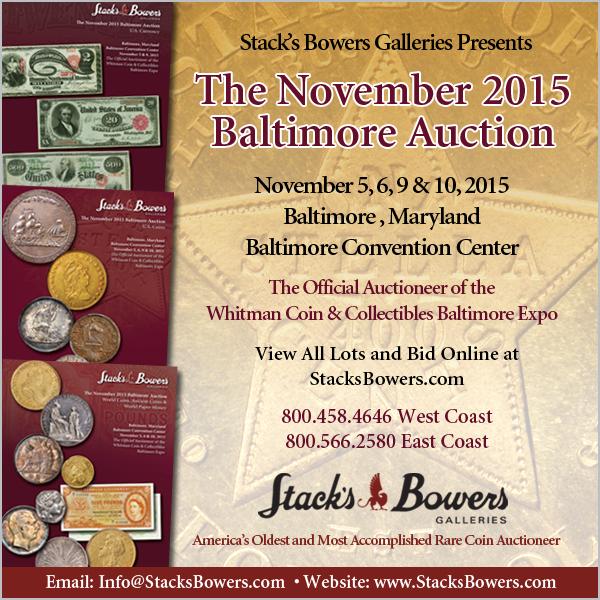
COIN COLLECTOR’S MANUAL: FIRST U.S. PRICE GUIDE
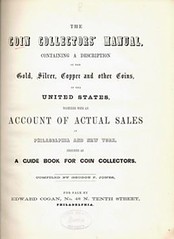 A quiz: When was the first guide book of United States coins published? Most will answer “1947,” the cover date of the Red Book’s
first edition. The correct answer is “1860.” In that last antebellum year, George F. Jones invented the retail price guide for American coins that
Whitman would, decades later, reprise for its Guide Book.
A quiz: When was the first guide book of United States coins published? Most will answer “1947,” the cover date of the Red Book’s
first edition. The correct answer is “1860.” In that last antebellum year, George F. Jones invented the retail price guide for American coins that
Whitman would, decades later, reprise for its Guide Book.
Coin collecting in America is older than the nation: numismatists were prowling the colonies by the 1750s. There were few “coin cranks” at first, but their numbers steadily increased. The hobby grew exponentially during the 1850s, but new collectors were flying blind: there were no reference books, no numismatic newspapers, no coin clubs, and few part-time dealers.
Enter the ingenious George F. Jones, with The Coin Collector’s Manual, which he stated was “Designed as a guide book for coin collectors.” How could Jones determine a coin’s value in the small market of 1860? He resourcefully discovered five guides from the recent past: the auction of John W. Kline’s collection in June 1855; Edward Cogan’s sale of his large cents in November 1858; Cogan’s auction of J.N.T. Levick’s collection in December 1859; Augustus B. Sage’s and Bangs, Merwin’s auctions in 1859; and Cogan’s sale of May 1860. For these events (all except Sage’s and Bangs’ held in Philadelphia), Jones recorded the coin’s price realized, and its condition.
So, for each listed piece — say, a 1796 Draped Bust dollar — there were up to five values provided from auction sales. These coins tended to be in varying conditions, which led to some curious comparisons. A 1799 Draped Bust cent in Fine condition, for example, had gone for $8 at the Levick Sale in 1859, but another only in Good went for $10 at Cogan’s sale just a year later. In explanation of such anomalies — proving that some things never change — Jones writes: “There are some apparent discrepancies where the condition of the coin sold, is represented as the same, [but] the prices are widely different. This can be accounted for in no other way, than that one coin collector or dealer may call a coin fine or very fine, when another would describe one exactly like it, only as good or fine.”
Another of Jones’ observations also reinforces the constancy of some numismatic maxims: “Coins in poor condition, unless decidedly rare, are receiving but little notice, while those which are good impressions, find liberal purchasers immediately.”
But some things do change, including numismatic nomenclature. Jones calls the 1793 chain cent a “link;” he lists a 1795 “Curious head” cent; and Jones calls the 1856 flying eagle cent a “buzzard.”
The Coin Collector’s Manual was published in a small edition, and is today quite rare. It was the Red Book decades before there was a Red Book, and humble though it was, opened the door to literally millions of guide books to follow.
To read the complete article, see:
What was the
first U.S. coins price guide?
(www.coinworld.com/news/us-coins/2015/10/first-u_s_coins-price-guide-published-in-1860-by-george-jones.html)

QUERY: JACK FRIEDBERG PHOTO AND ROBERT FRIEDBERG SIGNATURE SOUGHT
Dave Lange writes:
I'm really close to submitting my manuscript about coin albums produced by the Coin & Currency Institute to the book designer, but I want to tie up a few remaining loose ends. I presently have a photograph of Robert Friedberg and a signature of Jack Friedberg. I'd like to complete these items, so I'm seeking a signature of Robert's and a photo of Jack that I may reproduce in my book on their line of coin albums.
QUERY: 1997 SIGNED RED BOOK INFORMATION SOUGHT


I was recently able to acquire the attached copy of the leather 50th Anniversary edition that was produced by Whitman for the Red Book. Originally produced in 1200 pieces, with the special insert, they were sold without Ken Bressett’s signature.
However, I acquired the attached copy with a ‘special’ plate saying: “A Guide Book of United States Coins”, [Signed by Ken Bressett] then: “Ken Bressett, Editor of the Red Book and President of the A.N.A.”
I have corresponded with Ken, and he says that it is indeed his signature, however, he has no recollection of when or why this was made.
Any readers who may be able to help with any information would be greatly appreciated. I would like to know if anyone has seen this before, any copies in their libraries, and any info about where, where or how distributed.
NOTES FROM E-SYLUM READERS: NOVEMBER 8, 2015
Mystery of the Upside-Down Treasurer
 George Kolbe writes:
George Kolbe writes:
The NBS Treasury is upside down? Or is it merely the Treasurer?
Pete Smith writes:
When Terry White was asked to serve as NBS Treasurer, I understand his response was, "I could do that job standing on my head!"
The PayPal option is working well. Terry reports that we already have four new members who've signed up that way, along with one renewing member. As regular memberships expire at the end of the year, more may wish to use the PayPal option. -Editor
To read the earlier E-Sylum article, see:
NBS TREASURER TERRY WHITE OFFERS PAYPAL OPTION
(www.coinbooks.org/esylum_v18n44a02.html)
Great Recent Articles
Dave Bowers writes:
Catching up with my reading I have on hand the MCA Advisory, ANS Magazine, Penny-Wise, and the C4 Newsletter. These four magazines and the organizations behind them—the Medal Collectors of America, the American Numismatic Society, Early American Coppers, Inc., and the Colonial Coin Collectors Club—are what the art and science of numismatics is all about (and I give a nod to the ANA, CWTS, TAMS, and other great groups whose publications I enjoy, but are not in the unread pile I have here).
I dare say that if copies of these four magazines were given to just about anyone of literary and historical persuasion and read, they would automatically become dedicated numismatists! How wonderful these magazines are. I anticipate spending several hours absorbing them. What treasures!
For more information about the organizations, see:
www.medalcollectors.org
http://numismatics.org/
www.eacs.org
www.colonialcoins.org
Quick Quiz: Art and Artists on the Monuments Men Medal
Jim Duncan from New Zealand writes:
I have purchased a "Monuments Men" medal from the US Mint - fabulous service! But I cannot identify all the works of art on it.
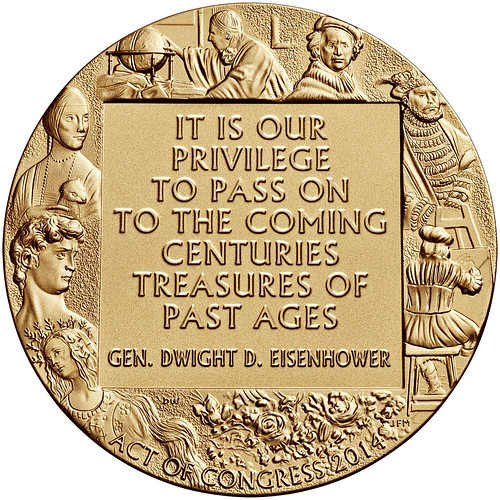
To read the earlier E-Sylum article, see:
MONUMENTS MEN RECEIVE CONGRESSIONAL GOLD MEDAL
(www.coinbooks.org/esylum_v18n43a27.html)
Clock Token Issuer: Harvey R. Caberey

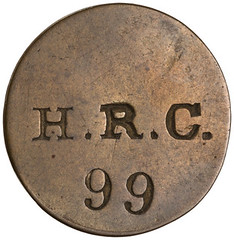
“H.R.C.” is HARVEY R. CABEREY (b. Oct. 15, 1822, Cornwall, Orange County, NY – d. between 1892 and 1896, Chicago. IL).
Caberey moved to Chicago 1849 after marrying 1844 in NY, Ruth Whatley (b. 1826, New Jersey – d. @ 1905, Chicago,IL)
Sherwood & Whatley were Chicago firm of silversmiths, jewelers, watchmakers. [Smith Jones Sherwood & Eli Whatley were partners who made/retailed coin silver, not sterling silver, objects late 1840’s – 1850’s.].
In 1855, Caberey took over firm Sherwood &Whatley until selling out 1862. Then Caberey manufactured and dealt military goods. Then he sold Masonic regalia etc. until his death.
Sherwood & Whatley had an establishment at Lake and Dearborn Streets, Chicago, with a clock outside. That clock indicated the Standard Time kept by the railroads which rail passengers were advised to consult.
Thus the token imagery is explained and it can be dated between 1855 and 1862 probably. Not explained is what token used for although would seem to indicate a receipt for an item.
To read the earlier E-Sylum articles, see:
QUERY: H.R.C. CLOCK TOKEN INFORMATION SOUGHT
(http://www.coinbooks.org/esylum_v18n43a23.html)
NOTES FROM E-SYLUM READERS: NOVEMBER 1, 2015 : More on the H. R. C. Clock
Token (www.coinbooks.org/esylum_v18n44a11.html)
India 2015 -Indo African Summit Coin
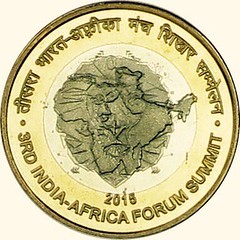 Regarding an Indian coin for the Indo-African Summit, last week I asked:
Regarding an Indian coin for the Indo-African Summit, last week I asked:
Um, what the heck IS this mess? Superimposed maps? I'm totally lost on this one.
Chip Howell writes:
I think you should have a dermatologist look at that one.
Pabitra Saha says the coin display the logo of the summit, which he provides here. In color, it makes some sense. I was right about the superimposed maps, but couldn't see the lion. Nice, but not a good base for a coin design.

Pabitra Saha adds:
Apart from the Lion ( which is found only in Africa And India), the logo has diamonds (Africa is the largest producer and India is the largest processor).
To read the earlier E-Sylum article, see:
SOME RECENT COIN DESIGNS: NOVEMBER 1, 2015 : India 2015 -Indo African Summit
(www.coinbooks.org/esylum_v18n44a38.html)
A Premature Death
Regarding the headline of last week's article on the bookseller trade token dies of Henry Morris, Dave Lange writes:
I'm always saddened to learn of the passing of another beloved token...
To read the earlier E-Sylum article, see:
HENRY MORRIS' BOOKSELLER TRADE TOKEN DIES
(www.coinbooks.org/esylum_v18n44a29.html)
Mint Bag Wax, 1794 Large Cent Find
 Dan Demeo writes:
Dan Demeo writes:
1. The wax on the old mint bag. I believe the seal was applied to the tie, after it was placed around the neck of the bag. Wax on the bag probably just collateral damage--doubt they would bother putting anything to catch inadvertent drips. Not like dentistry, where it's bad form to leave blood spots on your shirt.
2. The 1794 large cent found in England appears to be shielded hair, S65, S64, or, don't I wish, NC-6. The obverse shows the heavy rim to the left, typical of shielded hair. The reverse determines the Sheldon variety, didn't see a reverse photo.
To read the earlier E-Sylum articles, see:
NOTES FROM E-SYLUM READERS: NOVEMBER 1, 2015 : An Early U.S. Mint Canvas Coin
Bag (www.coinbooks.org/esylum_v18n44a11.html)
1794 CENT DISCOVERED IN ENGLAND (www.coinbooks.org/esylum_v18n44a18.html)
Dictionary of Banking Terms and Phrases
John and Nancy Wilson write:
In November we are going to present a program on Florida Checks, showing one check from cities from A to Z. While getting background information we found this excellent site for checks on www.helpwithmybank.gov that shows from A to Z a Dictionary of Banking Terms and Phrases. E-Sylum readers might like the information and the link for the information is: http://www.helpwithmybank.gov/dictionary/index-dictionary.html
THE BOOK BAZARRE
MORE ON REMOVING PRICE STICKERS FROM BOOKS
The ability to successfully remove an unwanted label depends on the label, the adhesive and the material to which it is attached.
Labels are most easily removed where the tensile strength (stretchability) of the label is greater than that of the adhesive, and where the surface to which the label is attached is relatively firm and smooth. Sometimes they can peel right off, most times one has to take it slowly and carefully. Labels on fragile material are best left alone for fear of tearing or damaging the underlying material.
If the surface below the label is impervious (such as hard or soft plastic, coated paper or mylar), you can usually remove sticky or gummy traces from the surface with a small piece of paper towel moistened with a cleaning product called Simple Green. After use, be sure to wipe off the Simple Green, which is a chemical that may react over time, with a water-moistened paper towel.
To read the earlier E-Sylum articles, see:
ANSWERS: REMOVING PRICE STICKERS FROM BOOKS
(www.coinbooks.org/esylum_v11n25a14.html)
NOTES FROM E-SYLUM READERS: NOVEMBER 1, 2015 : Removing Price Stickers From
Books (www.coinbooks.org/esylum_v18n44a11.html)
CONFRONTING THE LEGACY OF WALTER BREEN

Twenty-two years ago, noted numismatist Walter H. Breen died at Chino’s California Institute for Men, part of the California Department of Corrections and Rehabilitation. A convicted serial child molester, it’s hard to imagine that Breen’s stay at the facility was ever meant to rehabilitate the man. Instead, that duty seems to have fallen to a very few of his friends and associates in the world of numismatics, a community that benefited tremendously from Breen’s work for over 30 years.
As numismatists, it’s difficult to be “objective” when writing about Breen. We benefit too much from what he did for the hobby, and most of us were not directly affected by the things Breen was accused of doing – and admitted doing – in his private life.
Plus, it evokes in many of us an impulse not to talk about him. Better to leave well enough alone lest it taints the hobby, one might argue. To this day, numismatists–ourselves included–continue to cite Breen’s work in auction catalogs, books, and articles; his sins sequestered from his expertise.
But does this reticence nurture, or possibly inflict, the very harm that some in the hobby worry about?
To an extent, we understand the impulse to keep quiet. Consider this: as a hobby and an industry, we’re actually quite fortunate that the Breen scandal erupted when it did. Had Breen’s crimes come to light in the Internet Age, the hobby as a whole could have been implicated. And not because of some kind of guilt by association (though in some eyes that’s bad enough, and it’s an understandable fear). No, the problem lays in the deference the hobby showed to him, treating Breen like a guru or a numismatic “institution” that was “too big to fail”. The industry could have experienced something like what happened to Pennsylvania State University, when public opinion accused the University and its fans of prioritizing football over the safety and lives of underprivileged children. That scandal didn’t just bring down a child molester, it ended the career–if not the life–of a Hall of Fame football coach and tarnished the reputation of one of the nation’s most prominent public universities.
That didn’t happen to coin collecting. Yet the fact remains that by continuing to so closely associate Breen with numismatics, we open ourselves up to the same criticism and contempt.
Silence about his crimes merely reinforces those ties.
We doubt that Jerry Sandusky and his achievements on the gridiron will be reevaluated on the basis of his football IQ, but for Breen, there remains the possibility that his reputation as a preeminent numismatist may be rehabilitated. We don’t say this to be alarmist; we say this because we know people who want to make it so.
But in some ways, it’s curious that Breen still lingers in our hobby. It’s been more than two decades since his last meaningful work was published. Much of what he knew and wrote has been superseded by more recent scholarship, and a number of his claims and theories have been discredited.
Walter Breen himself has no say in the matter. He has no heirs in the coin business. His children, who have accused him of crimes against them, have not lobbied on his behalf. The fact that some of us still do shows that it is we who continue to be drawn to him.
So let’s do what so many of us are loathe to do.
Let’s have that conversation about Walter Breen, the one that’s long overdue. The one we’re so afraid to have because of what we’re afraid it might say about us. The one that by not having it has said more about us than we’d like to admit.
For better or worse I knew Walter Breen in my younger days, corresponded with him on numismatic topics, and met him at various coin conventions and had him autograph his books for me. I even accepted a ride in his car (as an adult). Like most I was initially clueless about his non-numismatic reputation, although his other interests gradually became clear. Rumors of his proclivities found their way to me, and as a bibliophile I even once acquired copies of some of his non-numismatic works, including Greek Love. I never read them or got them signed.
In the days before the Internet made criminal records, trial transcripts and sexual predator lists widely available, separating facts from mere rumors was harder. But where there's smoke there's often fire, and the CoinWeek writers rightfully question "why Breen continued to thrive as a professional numismatist while at the same time carrying such baggage."
Early in my career I worked at a firm where a married manager was having an affair with a woman on the team he managed. When I had the opportunity I came out and asked his boss about it. The affair was an open secret and the boss acknowledged it. "So why is he still here, I asked?" I was basically told that his work for the company was deemed more important than the transgression. And so it was in numismatics, apparently.
Still, as the writers note,
... there’s no evidence that any one person, group of people or company shielded Breen from the consequences of his actions. Instead we have anecdotes regarding what many considered Breen’s peculiar behavior, told in earnest but nearly all uncorroborated by documentary evidence.
I had seen no evidence either, only heard the whispers. And those whispers weren't enough to lead me to shun Breen or call for his banishment. Like several in the hobby I could attest to the utility of his numismatic work based on facts and first-hand experience, and thought that deserved acknowledgement on its own merit.
I'm honestly not sure what I would have done had I known then all that I know now, including the sci-fi episodes, emails from Breen's daughter Moira, and comments such as David Quint's on the CoinWeek article. As noted earlier in The E-Sylum there were indeed high-profile numismatists such as John Pittman who openly disliked Breen.
In the numismatic world one of my clubs once learned that a regular member had been escorted off the ANA bourse floor for stealing coins. To his credit, he came to our next meeting in person to tell his story. He admitted the act and asked for our forgiveness. We discussed it, but of course could not allow an admitted thief to remain in our presence. We voted him out and never saw him again.
Also in my younger days I was called to serve on jury duty. As it turned out, it was a case of a man charged with the same offenses as Breen. But I didn't have to contend with whispers. My fellow jurors and I heard testimony directly from those involved, and we discussed all aspects of it. I gained faith in the jury trial system, because the disparate backgrounds of the people involved ensured that we looked at the evidence from all angles. Sentencing a man to prison isn't a decision to be taken lightly. But after hearing the evidence my vote was Guilty. It was unanimous, on the first round. But we would also have thrown the mother in jail if we could, for leaving the poor kid in the guy's care.
Hiring, firing, shunning, and banishing are not decisions to be taken lightly or made on the basis of rumors. We shouldn't be vigilantes, but we must remain vigilant. God Bless the woman dealer, who upon hearing a young numismatist's mother planning to introduce her son to Breen at a coin show, got in her face and said "Don't you ever leave him alone with THAT MAN!" -Editor
To read the complete article, see:
Confronting Breen (www.coinweek.com/education/confronting-breen/)
To read the earlier E-Sylum article, see:
TALE OF THE TAPE: PITTMAN, BREEN AND THE TAXAY BOOK BLURB
(www.coinbooks.org/esylum_v17n04a10.html)
THE BOOK BAZARRE
College Currency book by Schingoethe. Brand new, still sealed. $20 shipped
LUCK FOR MORSE COUNTERSTAMP
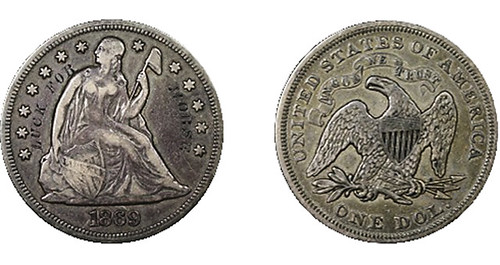
I recently acquired an addition to my collection of counterstamped Seated Liberty coins: an engraved 1869 Seated Liberty dollar with the words “Luck for Morse” on the obverse.
This dollar came with a theory that it may have a connection to Samuel F.B. Morse, American painter, inventor, contributor to the invention of a single-wire telegraph system, developer of Morse code, and contributor to the development for the commercial use of telegraphy, including transoceanic.
The 1869 France to United States cable was the first transatlantic cable that would emerge out of the ocean and land directly on United States shores — 25 years after Samuel Morse did his famous 10-mile telegraphy demonstration in the Washington, D.C., in 1844.
This cable had a much faster transmission rate than the two cables working in 1866, which were in turn faster than the initial 1858 cable, which failed after a short period. The 1866 effort had a transmission capability 80 times faster than the original 1858 technology, which took many minutes per individual character.
By 1869, it was possible to transmit several words per minute. For that reason the original groups organized by Cyrus West Field were reported to have opposed the French effort, completed by May 1869. This later effort had the potential to be faster and therefore cheaper than the cables promoted by Field. This was the highest technology of the day, and for both groups of entrepreneurs, the works required the massive British ship Great Eastern, the world’s largest ship for some decades.
The French effort also needed three support vessels — plus the thousands of miles of specially constructed cable of massive weight. There was as subscription of 60,000 shares at a then-typical initial public offering price of $100 per share, which resulted in a $6 million venture.
The stakes were very high. If the cable broke halfway out in a middle ocean storm that tossed the ships around, they might not be able to find the broken ends, over 2 miles below the ocean surface at midpoint.
At this level of financing in 1869 for a venture of this nature, they were relying on a lot of “luck” as to what conditions they would encounter at sea and whether the cable’s technology would work as planned, and with a minimum of surprises.
A dollar was a good day’s pay in 1869, so few people would inscribe words to make a souvenir of one unless it was for some very important reason or occasion. This engraved 1869 Seated Liberty dollar was not otherwise personalized to commemorate some day or event, and gives no indication that it was worn — which would be unexpected with a sea voyage. This dollar was likely a pocket piece, perhaps carried by an official or worker onboard a ship in 1869, and now it is in my collection.
To read the complete article, see:
Could
mysterious engraved message on 1869 Seated Liberty dollar honor telegraph?
(www.coinworld.com/news/us-coins/2015/11/could-mysterious-engraved-message-on-1869-seated-liberty-dollar-.all.html)
A FIRST-RELEASE 1943 STEEL CENT ENVELOPE
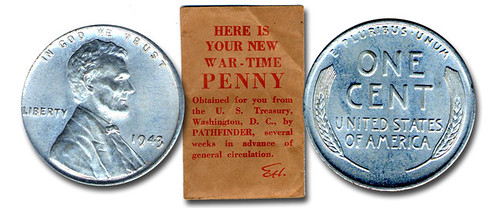
A recent trip to one of my favorite internet auction services produced a 1943 steel cent in Mint State. Though it is not a rare item by any stretch of the imagination, the coin I now own is housed in a faintly tattered manila paper envelope which reads: “HERE IS / YOUR NEW / WAR-TIME / PENNY / Obtained for you from / the U.S. Treasury, / Washington, D.C., by / PATHFINDER, several / weeks in advance of / general circulation” on 10 lines in red ink. It is machine signed “E.H.” in fancy script. This is the first one of these I have ever seen in 50+ years of collecting, and I immediately purchased it for well under $10. The leading third-party grading services churn out “First Release” and “Early Release” slabs at every turn whenever a new issue is minted. I can’t help but wonder whether I could get this Mint State 1943 “steelie” in a “First Release” holder from one of the grading services? After all, it is a bona-fide early release!
So who was E.H.? And what was PATHFINDER? Guessing that it might have been a publication, I found an entry in the Encyclopedia Britannica stating that "Time magazine’s immediate forerunner was the Pathfinder (1894–1954), a weekly rewriting of the news for rural readers."
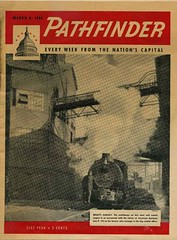 I found several offerings of the magazine on eBay. Here's an image of a 1944 issue, where the cover touts it as publishing "Every
Week From The Nation's Capital". A column titled "The Week at Home" contains articles headlined "Sugar Supply Cut" and
"Fuel Shortage". All of that ties in with the theme of the Steel Cent envelope, but doesn't prove a connection.
I found several offerings of the magazine on eBay. Here's an image of a 1944 issue, where the cover touts it as publishing "Every
Week From The Nation's Capital". A column titled "The Week at Home" contains articles headlined "Sugar Supply Cut" and
"Fuel Shortage". All of that ties in with the theme of the Steel Cent envelope, but doesn't prove a connection.
Perhaps an article or ad could be found in an earlier issue outlining the offer of a new cent for readers. Or perhaps they were just given away as souvenirs, and there was no documentary evidence. So we may never know for sure. But a great piece of numismatic ephemera regardless, and one that should be preserved and documented for future collectors and researchers.
I also reached out to one of our favorite old-timers, Harvey Stack, to see what he remembers. -Editor
Harvey Stack writes:
It has been so many years gone back when I encountered presentation envelopes for the 1943 Cent. I do not know if these were privately made. or actually issued by banks or the Mint to acquaint receivers of the new steel metal used.
I remember seeing small groups of these at one time, and they were possibly packaged by the Mint for visitors to pay 1 cent or maybe 5 Cents each as a souvenir.
I remember seeing similar envelopes (with and without coins in them) as the Mint introduced the 'silver' nickel, and drew to the receiver's attention that these were marked on the reverse with large letters "P, D or S" designating they had silver in the coin.
I also remember, about that time, and years later, that one would find small bags of cents, ie Ten Cents, issued by the mint, also as a souvenir and if I remember correctly they were sold at 10 cents or 20 cents a sack, also at the Mint.
In 1942 the Mint issued 5 piece and 6 piece Proof sets, and also sold Cents and Five Cents of each separately, at a very small premium to be used in the Lincoln Head Cent Sets and Jefferson Nickel sets. Also, in 1942 they sold the entire set, in proof, consisting of one cent, both Five cents, a Dime, Quarter, and Half Dollar (the Five Cent, Dime, Quarter and Half Dollar were SILVER) for $2.10. (a small premium above face !!!)
Today, the Mint is much more profitable, they sell All their products at substantial high premiums, most are mounted in special cards, boxes and booklets, to make them look rare and desirable and the profit they make is many times face value.
So in the earlier days, the Mint made inexpensive Souvenirs; today they are more in the market for promotional items at the cost of the collectors.
To read the complete article, see:
A
First-Release 1943 Steel Cent (www.stacksbowers.com/NewsMedia/Blogs/TabId/780/
ArtMID/2678/ArticleID/65443/A-First-Release-1943-Steel-Cent.aspx)
To read the Encyclopedia Britannica article, see:
Pathfinder : American magazine (www.britannica.com/topic/Pathfinder)
To read the complete eBay lot description, see:
Pathfinder News
Magazine, Every Week From The Nations Capitol, March 6,1944
(www.ebay.com/itm/Pathfinder-News-Magazine-Every-Week-From-The-Nations-Capitol-March-6-1944-/151602309625)

ARTICLE FEATURES SARATOGA QUARTER DESIGNER BARBARA FOX
This article from the Olean Times Herald of Olean, NY features Barbara Fox, designer of the new Saratoga National Historical Park quarter. The article does not include a picture of Fox or her designs, but I'm added an image from the U.S. Mint web site. -Editor
One of artist Barbara Fox’s recent designs turned out to be right on the money — literally.
The Ellicottville-based artist will be recognized later this month when the United States Mint hosts its newest America the Beautiful Quarter Launch and Coin Exchange in Schuylerville. The event marks the official release of the Saratoga National Historical Park quarter, which was designed by Fox.
 The quarter illustrates the October 1777 surrender at Saratoga of British Lt. Gen. John Burgoyne to Gen. Horatio Gates of the American
Continental Army. The design is a representation of the British officer handing his sword to the American general.
The quarter illustrates the October 1777 surrender at Saratoga of British Lt. Gen. John Burgoyne to Gen. Horatio Gates of the American
Continental Army. The design is a representation of the British officer handing his sword to the American general.
The British surrender was a pivotal moment in the Revolutionary War. “Gentleman Johnny” Burgoyne had attempted to secure the Hudson River valley and link up with British forces in New York City, thereby isolating New England from the rest of the American colonies to the south. Meanwhile, the outcome of the campaign convinced the French to openly and actively help the Continentals in their war for independence.
The coin is the 17th coin or medal designed by Fox for the U.S. Mint, as well as her third quarter design. She designed America the Beautiful quarters for Montana’s Glacier National Park in 2011 and Maine’s Acadia National Park in 2012.
Fox visited Saratoga National Historical Park to take photographs and draw inspiration, and conceived the design after watching a movie in the park’s museum which included a recreation of the surrender scene.
“Designing for such a tiny round ‘canvas’ is a complicated assignment,” Fox said, “and I wanted the image to be beautiful and readily understandable. I chose an extreme close-up because it made the hands and the sword the center of attention.”
The design was checked for historical accuracy (down to the embroidery and engraved buttons) by historians at both the Smithsonian Institution and Saratoga National Historical Park. Also included in the design is the inscription “British Surrender 1777.”
The coin was sculpted by U.S. Mint sculptor-engraver Renata Gordon.
The quarter launch and coin exchange for the Saratoga quarter is set for Nov. 16 at Schuylerville High School; a coin forum in regard to the new quarter release will be at the Saratoga Town Hall in Schuylerville.
The America the Beautiful Quarters Program will release a total of 56 quarters between 2010 and 2021 depicting locations around the U.S. that are notable for their natural beauty or historical significance.
Fox works as a fine artist and illustrator from her Mill Street studio in Ellicottville. Her paintings have been featured in solo and group exhibitions in museums and galleries throughout the U.S., and she teaches her watercolor painting technique in classes and workshops around the country. She is working on new oil paintings for a solo exhibition in 2016.
To read the complete article, see:
State and Union: U.S. Mint quarter designed by
Ellicottville artist (www.oleantimesherald.com/article_51830ee4-8382-11e5-a871-6b2a3085885b.html)
ARTICLE FEATURES RICHMOND DEALER JERRY SCHMIDT
 Coins connect us to the past, Jerry Schmidt said. They are, literally, pieces of history.
Coins connect us to the past, Jerry Schmidt said. They are, literally, pieces of history.
“It’s amazing to think that you can hold a coin in your hand and realize that Jesus Christ might have held this widow’s mite in his hand,” Schmidt said.
The mite, a small bronze coin in circulation in Jerusalem more than 2,000 years ago, is just one example of the many historic coins Schmidt has handled in his decades as a coin collector and dealer.
Schmidt, 84, was saluted with a retirement cake Sunday during the Richmond Coin Club’s annual fall coin and currency show at the Clarion Hotel on North Boulevard. Schmidt said the show — which drew about 40 dealers and 700 prospective customers — may be his last show as a dealer, though he left open the possibility that he may return as he liquidates his inventory of thousands of coins.
Schmidt’s involvement with coins has been a lifelong fascination — starting when he had a paper route as a boy and studied the pennies he got when he collected payment from his customers.
A Thomas Jefferson High School graduate, Schmidt went into the Air Force in 1950 and became an intelligence officer. “I was a Chinese linguist,” he said. “The Air Force sent me to Yale to learn the language.”
He spent time in Korea, China, Japan, Southeast Asia and the Middle East. Though he never got a college degree, he studied at the University of Omaha, Virginia Commonwealth University, American University and the University of Alexandria in Egypt.
During his travels with the Air Force, Schmidt was on the lookout for coins. In 1962, he said, he came upon a Japanese collector who had a hoard of more than 2,000 13th-century Asian coins.
“I bought them all from him,” Schmidt said. “I paid him $700. That was a lot of money back then for me on my Air Force pay.” He said the moment he bought that trove of coins was when he became a dealer.
Schmidt retired from the Air Force in 1970 after 20 years, came home to Richmond and opened the Imperial Coin Shop. The business took its name from its location in the Imperial Building on the corner of North Fifth Street and East Franklin Street. “I just adopted the name,” he said, “and, besides, I had a lot of Imperial Chinese coins.”
In 1993, having outgrown his downtown shop, he bought land and built a store at 8801 Patterson Ave. He maintained his shop there until 2007 and, since then, has done much of his work as a dealer at coin shows. He has been a fixture at the Richmond club’s two annual events and until recently traveled frequently to shows across the U.S. and around the world.
To read the complete article, see:
Local coin connoisseur still circulating but
nearing retirement (www.richmond.com/news/article_66553233-b1ea-578e-94a4-047d7236cad7.html)
THE BOOK BAZARRE
JAMES RIVINGTON (1724-1802)
He's been working for years researching 18th century American numismatists and dealers, and has uncovered quite a bit of information that pushes back our knowledge of this area by over a century. His book will be titled Numismatic Collecting in 18th Century America.
This week's subject is James Rivington - colonial printer, bookseller, patriot, spy, and coin dealer. -Editor
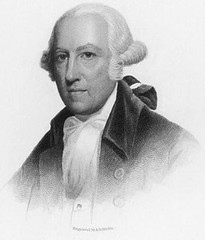 James Rivington (1724-1802), was born the son of Charles Rivington (1688-1742) and Eleanor Pease (d. 1753), at Chesterfield, Derbyshire,
England. He was a member of a family of booksellers at St. Paul’s Church-Yard, London, which did business there for over a century. From the mid
1750’s he was a notorious bookseller known for undercutting his competitors by purchasing bootleg copies from country printers of popular titles.
James Rivington (1724-1802), was born the son of Charles Rivington (1688-1742) and Eleanor Pease (d. 1753), at Chesterfield, Derbyshire,
England. He was a member of a family of booksellers at St. Paul’s Church-Yard, London, which did business there for over a century. From the mid
1750’s he was a notorious bookseller known for undercutting his competitors by purchasing bootleg copies from country printers of popular titles.
In order to steal away other English bookseller’s customers he advertised in America to sell at a 16 percent discount and a year’s credit. His large volume shop acted as a clearinghouse moving more stock than all of his competitors combined. After going bankrupt from gambling losses at the Newmarket races in 1758, he immigrated to New York in 1759, and opened a bookshop at Hanover Square with Samuel Brown, corner of Market and Front Streets, trading as Rivington & Brown. This is the same place that two years previous the earliest documented American coin auction had taken place by William Proctor (q.v.).
The following year, 1760, he moved to Philadelphia to set up shop leaving the New York shop in the hands of his partner Brown. He returned to New York in 1762 and sold many articles besides books including art, curiosities and medals of King George and Queen Charlotte as advertised in the Pennsylvania Gazette, Thursday, April 22, 1762, page 4. Consequently, Rivington together with Peter McTaggart (q.v.), John Green and Joseph Russell trading as Green & Russell (q.v.), and Edmond Milne (q.v.) are among the earliest known coin dealers in America.
Nevertheless, he opened a third bookstore at Boston with a new partner. After twelve years at New York he entered the newspaper industry and began to publish on April 22, 1773, The New York Gazetteer or the Connecticut, New Jersey, Hudson's River, and Quebec Weekly Advertiser (1773-1775).
Though he averred to be a free “open and uninfluenced press” by November 1774 he was labeled as being a Loyalist. At that time he boasted of a circulation of 3,600 throughout the colonies. No patriot knew that in 1775 he was one of the very first agents in the secret service to the newly appointed General George Washington. Rivington suffered severe public, social and financial losses to keep up the appearance of being a Loyalist in order to be a convincing spy for the Revolutionary War's Continental Army.
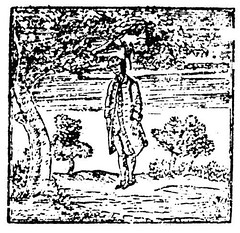 He was believed to be a Tory sympathizer throughout the Revolutionary War, which lead New Jersey patriots at New Brunswick to hang him in
effigy. Rivington had a woodcut engraved depicting that event and printed it in his paper with condemnatory words to suit.
He was believed to be a Tory sympathizer throughout the Revolutionary War, which lead New Jersey patriots at New Brunswick to hang him in
effigy. Rivington had a woodcut engraved depicting that event and printed it in his paper with condemnatory words to suit.
“In consequence of his repeated attacks upon the Sons of Liberty, and especially Captain Isaac Sears, that officer came to New York from Connecticut with seventy-five horsemen, and, entering Rivington's office, destroyed his press and converted the types into bullets. Rivington's conduct was examined by the Provincial Congress, which referred the case to the Continental Congress, and while the latter was considering it the publisher wrote a remonstrance declaring, "that however wrong and mistaken he may have been in his opinions, he has always meant honestly and openly to do his duty as a servant of the public."
He then made his peace with the Whigs, and was permitted to return to his house, but having incurred suspicion he afterward went to England, where he was appointed king's printer for New York. In 1777, after the British occupation of that city, he returned with a new press, and resumed the publication of his paper under the title of Rivington's New York Loyal Gazette, which he changed on 13 December, 1777, to The Royal Gazette.
On the day when Major John André was taken prisoner his "Cow Chase" was published by Rivington. About 1781, when the success of the British was becoming doubtful, Rivington played the part of a spy, furnishing Washington with important information. His communications were written on thin paper, bound in the covers of books, and conveyed to the American camp by agents that were ignorant of their service. When New York was evacuated, Rivington remained in the city, much to the general surprise, removed the royal arms from his paper, and changed its title to Rivington's New York Gazette and Universal Advertiser. But his business rapidly declined, his paper ceased to exist in 1783, and he passed the remainder of his life in comparative poverty.”
 And so it was believed by the biographer of Appleton's Cyclopedia. However, Rivington was merely changing professions from a
newspaper publisher back to being a bookseller, who, also sold coins like he did twenty years earlier; the basis of the model in the line of selling
curiosities, art and coins in what has come to be known in the United States as the classic Ye Olde Curiosity Shoppe, which has enjoyed great
popularity in America through these last two centuries.
And so it was believed by the biographer of Appleton's Cyclopedia. However, Rivington was merely changing professions from a
newspaper publisher back to being a bookseller, who, also sold coins like he did twenty years earlier; the basis of the model in the line of selling
curiosities, art and coins in what has come to be known in the United States as the classic Ye Olde Curiosity Shoppe, which has enjoyed great
popularity in America through these last two centuries.
His advertisement published in the late fall of 1782 reads : “To the Curious, For Sale, A Number of Foreign Coins, Gold, Silver, and Copper, many of them Ancient. – Enquire of the Printer.” Royal Gazette, Saturday, November 2, 1782, page 3, column 3. It was during the end of The Royal Gazette newspaper (1777-1783) that he published his own advertisement for the sale of these coins. The anti-royalists called his paper the “Lying Gazette.” Rivington’s newspaper had suffered from his believed to be political affiliations and so he turned to coin dealing by the late fall of 1782. He ceased publishing about a year later on December 31, 1783.
His first marriage in 1752 to Elizabeth Mynshull (1752-1769), bore him three sons : James Rivington, Jr. (1769-1809), Henry Rivington (1770-?), and John Rivington (1772-1795), who became Maj. John Rivington. A decade after the death of his first wife he remarried on March 9, 1779, to Elizabeth Van Horne (Van Hooren) (d.1795), who bore him two sons and two daughters. This is attested to by the 1790 U. S. Census, which reported that he lived in the East Ward, New York City, New York, and had three sons at least sixteen years of age and two under, a wife and two daughters and eight slaves. He, like Thomas Jefferson died on the 4th of July, except in the year 1802 at New York City, New York.
To read the complete article, see:
RIVINGTON,
JAMES (https://sites.google.com/site/numismaticmallcom/encyclopedic-dictionary-of-numismatic-biographies/rivington-james)
To read the earlier E-Sylum articles, see:
PETER MCTAGGART (1732-1825+) (www.coinbooks.org/esylum_v18n42a14.html)
GREEN & RUSSELL, COLONIAL BOSTON MEDAL DEALERS
(www.coinbooks.org/esylum_v18n43a13.html)
EDMOND MILNE (1724-1822) (www.coinbooks.org/esylum_v18n45a15.html)
FINKELSTEIN ON DR. DAVID RITTENHOUSE – PART 3
By David Finkelstein
Introduction
This is part 3 of a series of articles about Dr. David Rittenhouse, the first Director of the United States Mint. Over the last few
decades, multiple incorrect statements and theories about events during his lifetime and after his death have been published in numerous
numismatic articles and publications. In Parts 1 and 2, it was stated that a few researchers theorized that David Rittenhouse was
incarcerated in the Pruan Street (or Prune Street) debtor’s prison during 1796, 1797 and 1798, and that he, in fact, did not die in 1796.
His June 26th death, June 27th burial, and December 17th Eulogium was suggested to have been a massive cover up to maintain the integrity
of his image and to protect his reputation.
One conspiracy theorist has published, in writing, that:
- Dr. Benjamin Rush and William Barton were the perpetrators that falsely announced and covered up David Rittenhouse’s death, and
- Dr. Benjamin Rush used his position as Vice President of the American Philosophical Society (APS) to facilitate the cover up.
These falsities have been perpetuated simply because they were put in print, without any contemporary evidence to validate them. They have become accepted as being factual. They are not.
Falsity #3 – Dr. Benjamin Rush & William Barton covered up Rittenhouse’s death
In order for David Rittenhouse’s death to have been a massive cover up, one or more people had to have covered up his death. Dr. Benjamin
Rush and William Barton were falsely targeted as the perpetrators.
Dr. Benjamin Rush financed and edited Thomas Paine’s pamphlet that was originally titled Plain Truth. He convinced Paine to rename it to Common Sense. In July, 1776, Dr. Rush served as one of the seven Pennsylvania delegates at the Second Continental Congress. He signed the Declaration of Independence on August 2, 1776. He cofounded three colleges; Dickinson College, Franklin College (now Franklin and Marshall) and the College of Physicians. Dr. Rush was a delegate to the Pennsylvania convention that ratified the United States Constitution. He was also a practicing physician and chair of the Institutes of Medicine and Clinical Practice for the University of Pennsylvania. Not only is Dr. Benjamin Rush considered the father of American psychiatry, he is one of this nation’s founding fathers.
William Barton was a lawyer. In 1782, he served on the third committee tasked to design the Great Seal of the United States. He was also David Rittenhouse’s nephew.
These two individuals have been accused of maliciously deceiving the President and Vice President of the United States, members of Congress, government officials, foreign heads of state, the Rittenhouse family, and the hundreds of citizens of Philadelphia that attended David Rittenhouse’s Eulogium on December 17, 1796 at the First Presbyterian Church on High Street. If these two were complicit in the cover up, then so were David Rittenhouse’s wife, two daughters, and at least twelve members of the APS.
Per page 187 of Daniel K. Cassel’s book titled Genea-Biographical History Of The Rittenhouse Family And All Its Branches In America, With Sketches Of Their Descendants:
David Rittenhouse departed this life without a struggle & in the calmest manner, ten minutes before two o'clock on the morning of Sunday, the 26th day of June, 1796, in presence of his youngest daughter, Mrs. Waters, and William Barton. His excellent wife, who had ever been assiduous in her attendance on her husband, both in sickness and in health had retired from his chamber about two hours before, unable to support the awful scene of expiring genius and virtue.
On July 1, 1796, the APS held a special meeting regarding Rittenhouse’s death. 26 members of the APS attended. Per page 239 of Early Proceedings of the American Philosophical Society for the Promotion of Useful Knowledge, Compiled by one of the Secretaries, From the Manuscript Minutes of its Meetings, From 1744 to 1838 (hereinafter referred to as Early Proceedings):
Resolved “That this Society, deeply affected by the death of their late worthy President, do resolve - That an Eulogium, commemorative of his distinguished talents & services, be publickly pronounced…”
On July 5, 1796, the APS held another special meeting to appoint the orator. 22 members attended. Per page 240 of Early Proceedings:
The Society proceeded to the election of a member to prepare & pronounce the Eulogium… Dr. Benjamin Rush was duly chosen." Collin and Patterson to inform him of the fact.
Since Dr. Rush was informed, after the vote occurred, that he was elected orator, it is logical to conclude that he was not in attendance at the special meeting when the vote occurred. If he did cover up Rittenhouse’s death, there must have been additional coconspirators at the July 5th APS meeting to make sure that he was elected orator. Assuming a simple majority was required to elect Dr. Rush as orator, 12 of the 22 members in attendance were coconspirators, increasing the coconspirator count to 17. I find this to be totally absurd.
Falsity #4 – Benjamin Rush used his position of APS VP to facilitate the cover up
David Rittenhouse was President of the APS when he died. The conspiracy theorist has accused Dr. Benjamin Rush of using his position as
Vice President of the APS (and therefore acting President) to facilitate the cover up. This is completely false. First, Dr. Rush was not
Vice President of the APS in 1796. Second, as previously documented, he was not present at the APS meeting that elected him orator of
Rittenhouse’s eulogy.
Per the yearly election results published in Early Proceedings, Dr. Benjamin Rush was not an elected officer of the APS during calendar years 1793 through 1796. Per page 246 of Early Proceedings, he was elected Vice President of the APS on January 6, 1797. Since Dr. Rush was not an elected officer of the APS during 1796, he could not have used his position as Vice President to facilitate the cover up.
Final Thoughts: 6 months from Death to Eulogium
The conspiracy theorist published that he found it “strange” that David Rittenhouse’s Eulogium occurred 6 months after his reported death,
and Dr. Benjamin Rush took 5 months to complete Rittenhouse’s eulogy. There was nothing strange about this.
Per page 243 of Early Proceedings, at an APS meeting held on November 18, 1796:
Dr. Rush reported that he had prepared the Eulogium on Rittenhouse; Bleakley, Vaughan, Peale, Magaw, Patterson, appointed to report a time and place for its delivery.
Per pages 243 and 244 of Early Proceedings, at an APS meeting held on December 2, 1796:
Eulogium Committee reporting " they had obtained the privilege of the [First] Presbyterian church in Market street", "proposed Saturday the 17th instant at noon..." [Here follows a list of invitations, as in the case of the Eulogy on Franklin, commencing with "The President of the U. S. & his family", and closing with "College of Physicians, Family of Mrs. Rittenhouse, Mr. Benjamin Rittenhouse, Family of Dr. Rush."] - "The former Com. to be continued for the purpose of carrying the above into effect."
Finally, per page 244 of Early Proceedings, at an APS meeting held on December 16, 1796:
Peale and Vaughan "appointed to superintend & direct the introduction of the public bodies &c to their seats tomorrow in the Church…"
"It was moved & agreed that certain characters highly respectable, who have not yet been invited, should have tickets of invitation sent to them as soon as possible, viz. Mr. Boudinot, Director of the Mint, Dr. Way, Treasurer of the Mint, Mr. Meredith, Treas. U. S., Mr. Steele, Comptroller of the Treasury, Mr. Harrison, Auditor of the Treasury, Mr. Nourse, Register of the Treasury, Mr. Francis, Purveyor of the Treasury, Mr. Habersham, Postmaster General, Mr. Lee, Attorney General."
The conspiracy theorist failed to take into account that there was a Yellow Fever epidemic in Philadelphia during July, August, September and October of 1796. Dr. Rush was a medical doctor. He had a very lucrative practice, and at the time, was one of the nation’s experts on Yellow Fever. Since Dr. Rush was tending to the sick and dying during this 4 month period, it is logical to assume that it took 1 month (give or take) for him to develop David Rittenhouse’s 46 page eulogy, and not 5 months.
In 1796, it was the general (but incorrect) belief that Yellow Fever was contagious and airborne. David Rittenhouse’s Eulogium, comprising a gathering of approximately 600 people, including members of the executive, legislative and judicial branches of the United States government, was simply not going to happen during the Yellow Fever epidemic. [Note: it was not until 1901 that it was determined that Yellow Fever was an acute viral hemorrhagic disease caused by a bite from the female Aedes aegypti mosquito.]
In 1796, Philadelphians knew, based on prior year’s Yellow Fever epidemics, that when it got cold outside, Yellow Fever disappeared. Modern studies have shown that the Aedes aegypti mosquito struggles to imbibe blood below 57 degrees Fahrenheit. Considering Philadelphia’s climate history, the Aedes aegypti mosquito thrived during June, July, August, September and part of October. By November, no new cases were reported, and those that were inflicted were either dead or getting healthier.
As a result of the waning of the Yellow Fever epidemic, Dr. Rush was able to complete David Rittenhouse’s eulogy by November 18th, and the APS was able to schedule Rittenhouse’s Eulogium for December 17th.
To be continued…
To read the earlier E-Sylum articles, see:
FINKELSTEIN ON DR. DAVID RITTENHOUSE – PART 1
(www.coinbooks.org/esylum_v18n41a11.html)
FINKELSTEIN ON DR. DAVID RITTENHOUSE – PART 2
(www.coinbooks.org/esylum_v18n43a14.html)

THE SOCIETY OF RATION TOKEN COLLECTORS
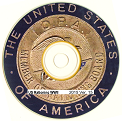 I read with interest, the featured web page: OPA Tokens. There is a club named "The Society of Ration Token Collectors (SRTC) that was
established in 1966 of which I am president. We are a member club of both TAMS and ANA and will be celebrating our 50th anniversary next year. While
the name of our club denotes tokens, we study the entire area of rationing that was in place during WWII. The area covers Food, Gasoline,
Automobiles, Bicycles, Typewriters, Stoves, Shoes and many other commodities. Tokens were introduced on February 27, 1944 to be used as change when
all ration stamps were validated for 10 points.
I read with interest, the featured web page: OPA Tokens. There is a club named "The Society of Ration Token Collectors (SRTC) that was
established in 1966 of which I am president. We are a member club of both TAMS and ANA and will be celebrating our 50th anniversary next year. While
the name of our club denotes tokens, we study the entire area of rationing that was in place during WWII. The area covers Food, Gasoline,
Automobiles, Bicycles, Typewriters, Stoves, Shoes and many other commodities. Tokens were introduced on February 27, 1944 to be used as change when
all ration stamps were validated for 10 points.
Membership dues are only $12 for quarterly publications and periodic auctions of ration material for members only. We publish a CD on WWII Rationing which includes known material from Canada and Newfoundland as well. It currently has over 2,100 pages of information and illustrations. Priced at $12 for members or $24 for non members (which includes a 1 year membership). Interested persons can contact me at: DKolkman@AOL.com
While the introduction of Mr. Cekola's book is very informative regarding the scarcity of certain tokens, I must disagree that the red "MV" is Ultra Rare; it is extremely scarce and certainly the key in the set, but there are several hundred known. He also states that the red "MM" is considered Rare, but it can be easily found. Also stated is that the blue "WC" is considered Ultra Rare, Again it is very scarce and is the key of the blues and probably the second key to the entire set, but it can be found.
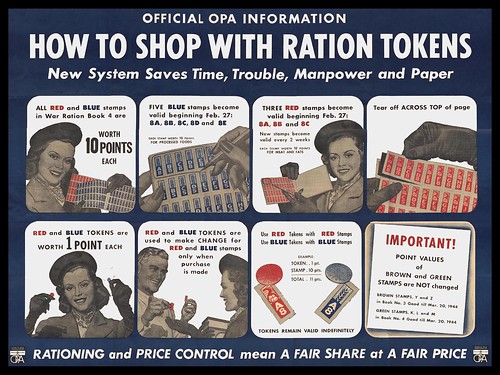
To read the earlier E-Sylum article, see:
FEATURED WEB PAGE: OPA TOKENS (www.coinbooks.org/esylum_v18n44a44.html)
SLIDESHOW: THE U.S. MINT IN DENVER, COLORADO
 The United States Mint is one of the Denver's most historic buildings, and has long-been one of Colorado's most popular tourist
attractions.
The United States Mint is one of the Denver's most historic buildings, and has long-been one of Colorado's most popular tourist
attractions.
The Mint, located at the intersection of West Colfax Avenue and Delaware Street, was originally built in 1863 following the gold rush of 1858, when thousands of miners and settlers flocked to Denver looking to strike it rich.
Now, 152 years later, the Mint is still pumping out all denominations of coins, from the penny to the dollar, and even commemorative coins and silver bullion.
It is one of six U.S. Mints, which employee more than 2,800 people and are located in Philadelphia, San Francisco, West Point Fort Knox and Washington, D.C.
The Mint offers public tours Monday through Friday from 10 a.m. to 5:45 p.m.
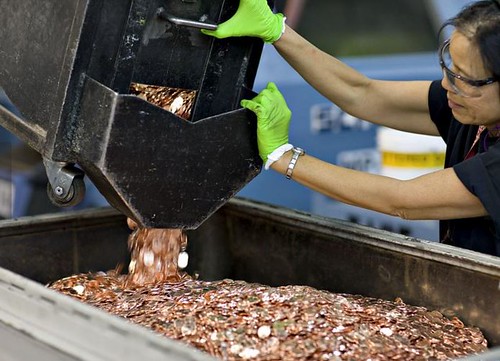
Press operator Siltham Smith
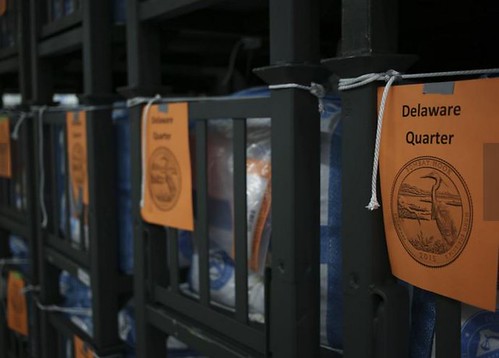
Bags of freshly-minted quarters await shipment
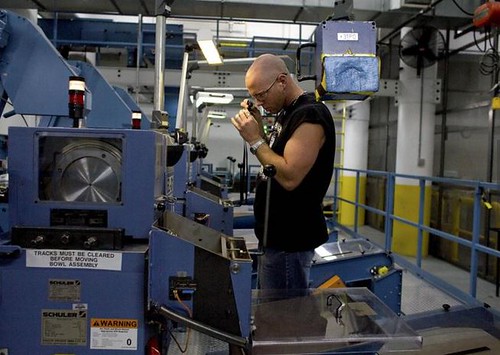
Press operator Chris Wright checks edge lettering on a new dollar coin
To read the complete article, see:
How your money
is made: A look inside the Denver Mint (Slideshow)
(www.bizjournals.com/denver/blog/broadway_17th/2015/11/how-your-money-is-made-a-look-inside-the-denver.html)
THE BOOK BAZARRE
WAYNE’S NUMISMATIC DIARY: NOVEMBER 8, 2015
Whitman Baltimore Winter Expo
On Friday morning, November 6, 2015 I pointed my car in a different direction; instead of heading to work, I went up to the Baltimore
Convention Center for a whirlwind visit to the Whitman Winter Expo.
I arrived early and hadn't arranged for an Early Bird Badge, so I cooled my heels in the lobby. Among the first people I spoke to was Wayne Herndon. As Virginians we naturally discussed the drive to Baltimore and how it's nearly impossible to arrive promptly at 9am. Wayne correctly noted that "If you leave at 7 you'll get here at 8. If you leave at 8 you'll get here at 10 or 11."
Next I spoke with Tony Terranova and John Dannreuther. We discussed a nice silver plug 1794 half they'd seen at the show. The plug was prominent and perfectly fitted, an unusual combination. The Mint got everything just right that day.
John and I also discussed numismatic literature. He mentioned a copy of the Adams-Woodin pattern book with blue and red check marks made by Abe Kosoff to record pieces in the Farouk and Newcomer collections.
As the doors opened for dealers I saw quite a crowd move thorough the hall. Among them I spotted Julian Leidman, Stu Levine, Mark Borckardt and Al Boulanger. I also spotted my old friend Bob Meztger and went up to chat with him. Decades have gone by since we last got together in person. I was single then and now I have a 6'2" highschooler at home. Bob was in Baltimore for the Colonial Coin Collectors Club (C4) meetings.
At the registration desk I met Ed Craig, a longtime E-Sylum subscriber and President of the Maryland Token and Medal Society. Ed and John Dannreuther both told me something I heard from people all day - that they always find something of interest in The E-Sylum. Ed had recently recommended it to a dealer he visited in a shop in Hawaii. That's how we get most of our subscribers - word of mouth. Thanks, Ed!
Another Marylander I met for the first time was Russ Sears. We'd corresponded for years but our paths had never crossed. I'm glad we made plans to get together for a while. We had a nice talk sitting at one of the lobby tables.
Finally, I also hooked up with Steve Davis from Michigan, who gave me a copy of his new auction sale catalog. His advertisement and press release of the sale is elsewhere in this issue. With the big coin auction firms getting even bigger, there is a niche for auctions of interesting lower-valued collector material, and we'll look forward to his future sales.
We entered the show floor when it opened to the public. I ran around to see several people in the short time I had available. Among my visits were the tables of Doug Winter, Charlie Davis and Neil Musante, and Dave Perkins and Andy Lustig. While speaking to Neil, Dave and Emi Hirt came by and we talked for a while.
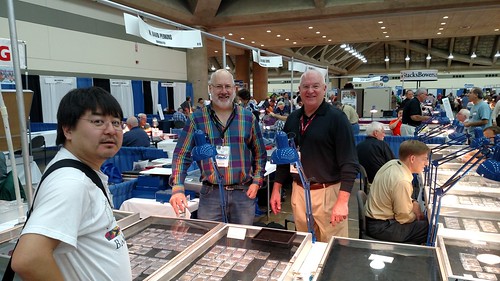
Steve Liu, Andy Lustig, Dave Perkins
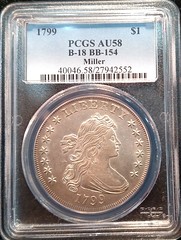 I took a look at some of the coins Dave and Andy were selling from the Miller collection. This nearly uncirculated 1799 dollar caught my
eye. Nice coin. I took the above shot while Steve Liu was visiting the table.
I took a look at some of the coins Dave and Andy were selling from the Miller collection. This nearly uncirculated 1799 dollar caught my
eye. Nice coin. I took the above shot while Steve Liu was visiting the table.
I couldn't stay long, because I'd made plans with Bob Metzger to go to an early lunch together. We met at John Kraljevich's table. I never got to talk to John as his table was always surrounded. People are drawn to him like flies on ... Well, maybe I need another metaphor. Let's just say he's popular.
Jeff Rock was there at the table and we discussed The E-Sylum and the CoinWeek Breen article. He was also there to make a deal with Bob Metzger, which they completed just as we were leaving for lunch.
Bob and I trekked across to street and took seats at an outdoor table. We both ordered the tuna tacos, which were very good. We filled each other in on our careers and families. When we were last together I was living in Pittsburgh and Bob was in Texas. Several job changes later I'm in Virginia and he's in Minneapolis, newly retired.
Bob showed me his new acquisition, It's a 1760 Voce Populi, Nelson-15. Nice coin!
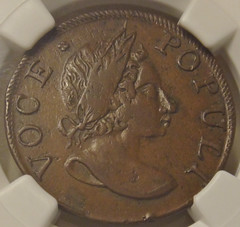
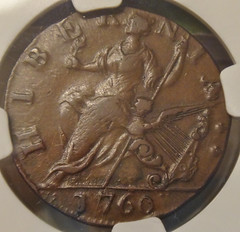
The Newman Numismatic Portal
 As noon approached we crossed back over to the convention center and made our way upstairs. Len Augsburger was getting set up to give a
presentation on the Newman Numismatic Portal. I joined him at the front of the room.
As noon approached we crossed back over to the convention center and made our way upstairs. Len Augsburger was getting set up to give a
presentation on the Newman Numismatic Portal. I joined him at the front of the room.
About fifteen people attended, among them Mike Packard, Dave Hirt, Bill Eckberg, Bob Metzger and David Gladfelter. We fielded questions about how books are digitized, and how people will be able to access the portal when it goes live. This is a big project and we're only getting warmed up. But it's been great to see the level interest and participation.
National Numismatic Collection Research Library
After chatting with Ray Williams and Bob Metzger and introducing Bob to Len, we said our goodbyes and began the journey to our next stop -
the National Numismatic Collection at the Smithsonian. Len stopped at his hotel while I pulled my car around to the Pratt street exit. I
set my Google Maps GPS navigation for our destination and we got caught up on Newman Numismatic Portal status along our southward
journey.
We found the building quickly enough and knew we had a parking spot reserved for us, but finding the parking lot was more of a challenge. Google was no help. "You have reached your destination" it told us. "Shut up", I thought. Len turned it off. We crawled through D.C. traffic and were still perplexed. Len called our host, Carrie Smith of the Smithsonian Libraries. Carrie went above and beyond the call of duty, coming to our rescue with her cell phone at her ear. She hopped in the back of our car and guided us to our parking spot.
I'm sure her mother taught her never to get in a car with strangers, but luckily for us Carrie made an exception. We introduced each other in the parking lot and crossed a street to the National Museum of American History building.
Once inside we passed the entrance to the new National Numismatic Collection exhibit and entered an elevator to an upper floor. These were the bowels of the Museum, the back room offices the public never sees. Carrie soon guided us to a numismatic bibliophile's paradise, the NNC's research library.
The outer room was lined with tall shelves stuffed with long runs of bound numismatic periodicals from all over the world. I made mental notes of publications to prioritize for digitization for the Newman Numismatic Portal. The Smithsonian Libraries already participate in digitization projects with the Internet Archive, and we met some of the people involved at the IA conference in San Francisco last month. The Smithsonian was involved with cataloging the NNC's library for the first time, and much progress has been made.
The catalog is available online, although it's still a work in progress. Here are Carrie's instructions on how to access it.
- Go to the Smithsonian library catalog: http://siris-libraries.si.edu/
- Use Browse option for known titles/authors/serial titles
- For a very general search use Keyword search
- General keyword: numismatic* [truncate the search term to pull variations] - this will give the most results
- Limit by: Search National Museum of American History (Note: there are other collections in the Smithsonian Libraries than at this location, but the majority will have the collection code NMAH Numismatics) (Note: the Dibner Special Collections Library also holds rare numismatics materials)
- Sort by: to further narrow the search
Carrie adds:
The library is still in process of reorganization. Contact Ask A Librarian with any questions.
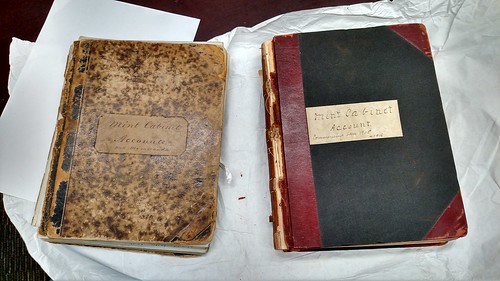
Mint Cabinet Account Books
When the U.S. Mint cabinet was transferred to the Smithsonian, these record books came along with it. Inside are entries describing each acquisition, whether donated or purchased. These hold great information and clues for researchers; unique materials like this will be among our top priorities for digitization.
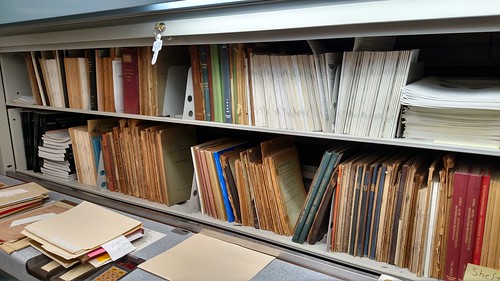
National Numismatic Collection Library Vertical Files
The cataloging effort is a work in progress, and much remains to be done. The inner room, which leads to the collection vault, holds a long row of movable bookshelves. Along another wall is this rotating vertical file holding thousands of pamphlets and auction catalogs. The books have been organized and are being entered in the online catalog. These files will take much more time to process.
Len and I had a ball perusing the library. We found a few great gems we'll follow up with the staff on. After a couple hours we bid our goodbyes and headed downstairs to take a look at the exhibit before leaving.
National Numismatic Collection Exhibit
The exhibit door was manned by the largest, burliest security guard I've ever seen in my life. The vault door was equally impressive,
even though it's just there for show. It's a great way to attract visitors to the exhibit. Here are some photos.
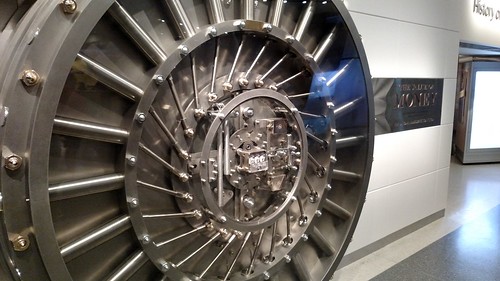
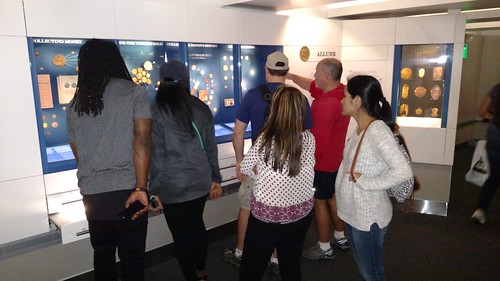
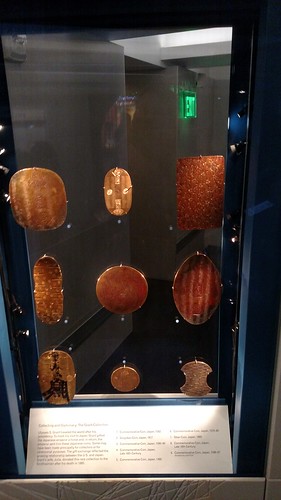
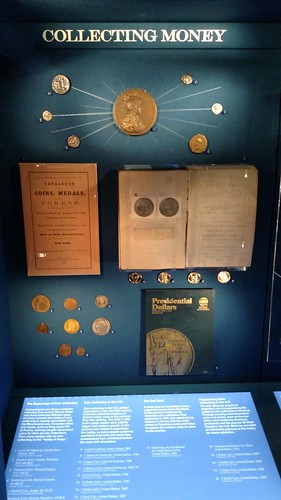
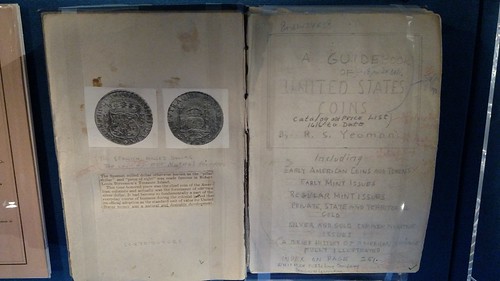
As bibliophiles, this item stopped us in our tracks - Dick Yeo's original handmade mockup for A Guide Book of United States Coins, the very first Red Book. Wow!
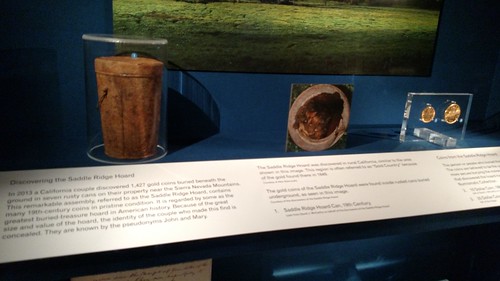
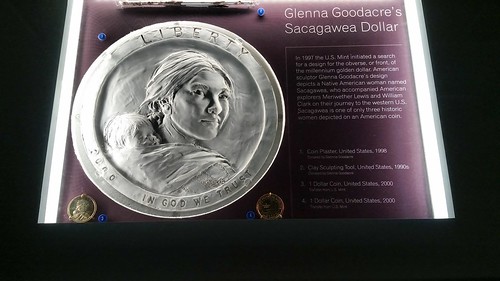
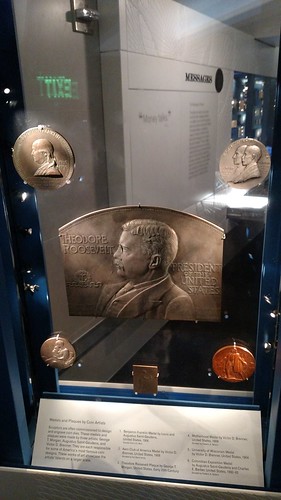
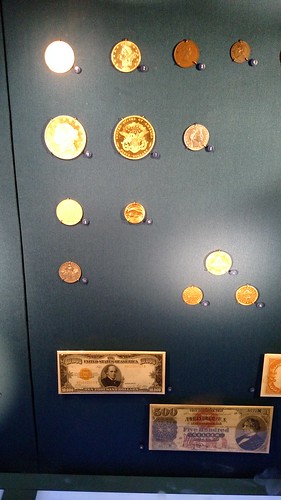
My kids will roll their eyes, but here's me taking a selfie. I enjoyed my brief visit to the exhibit. I thought it was generally well done and appropriate for a general audience.
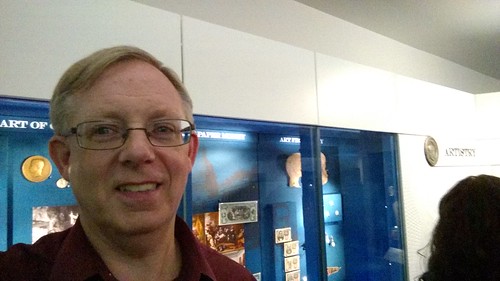
Len and I walked outside together, and then split up. He would take a train back to Baltimore while I drove home to Virginia. At least that was the plan. I discovered when I got to my car that I hadn't turned the key all the way off and my car battery was drained. It wouldn't start.
After a call to AAA and a short talk with the friendly attendant, I took a seat on a sidewalk bench to wait. It was a pleasant enough evening, so why not enjoy it? I just watched the world go by for a while, in cars, buses, bicycles and on foot. Even a 200-strong group of greenshirted middleschoolers went by.
Once my help arrived I was soon back on the road. I made it home in perfect time to meet up with my family for dinner at a local restaurant. All in all, a great day.
NOTES FROM LARRY GAYE
Two things caught my interest immediately in the last issue. First, the interview with Scott Semans. I don't remember having ever met Scott but could have in the past thirty or so years here in the Northwest. I have recently communicated with him on a new interest of mine, Chinese, Korean, and Annam cash coins. Scott has been very open with information and many rookie questions have been answered via phone and email and the acquisition of a new book. What a great resource we have in Scott and the numismatic literature community. Thanks Scott for your patience and guidance.
Secondly, the recent sale of the 1794 cent and story of its finding. I suppose every copper weeny is examining the photo and enjoying the story. There are many finds out there if you dig deeply. Of course a little luck is appreciated. At a recent coin show in Portland, Oregon I found two Santo Domingo 4 maravedis (copper) pieces struck during the reign of Juana and Carlos of Spain in a junk box. These were some of the earliest coins struck in the New World and fit very nicely into my Colonial America collection. I now have four examples, it is a very scarce coin especially in choice condition. It was an article in the C-4 that helped me identify my first find. Had I not had good books and access to journals, my numismatic journey would not have been possible. Thanks to all of you who make numismatic literature available. It is not easy hauling books around the country to conventions for the locals to parouse and purchase.
Kudos also to David Sklow and thanks to him for accepting the position as the new Library Manager at ANA. I'm sure he will do a fantastic job as the library has had many challenges. The library is an excellent benefit of ANA membership. Best of Luck David.
To read the earlier E-Sylum articles, see:
INTERVIEW: SCOTT SEMANS (www.coinbooks.org/esylum_v18n44a16.html)
1794 CENT DISCOVERED IN ENGLAND (www.coinbooks.org/esylum_v18n44a18.html)
DAVID SKLOW BECOMES ANA LIBRARY MANAGER
(www.coinbooks.org/esylum_v18n44a05.html)
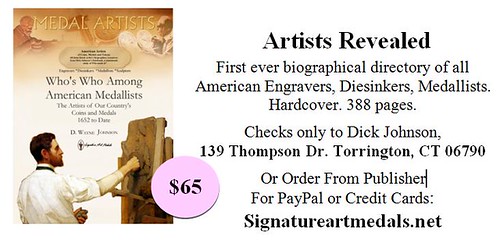
THE MEXICAN-AMERICAN ‘DOLLAR,’ CIRCA 1877

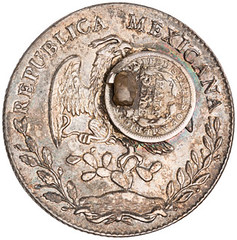
A few weeks back the ANS put together a display for the U.S.-Mexican Numismatic Association that included some of the highlights of our collection of Mexican coins and currency. Among the most remarked upon pieces was a rather unusual Mexican-American ‘dollar,’ which in actuality consists of an 1874 Republic of Mexico 8 reales, an 1850s-era US half dime, and a circa 1875 US dime. As you can hopefully make out in the photo ..., a copper rivet was driven through the three coins to join them together.
Explaining exactly why someone would do this is a rather complicated story. Let us begin with the Mexican coin, which was struck at the Guanajuato mint in 1874 and is of the traditional “Cap & Rays” design. During these years the Republic of Mexico was attempting to transition to a decimal-based monetary system centered on the peso, but the older Spanish real denominations proved so durable that they continued to be produced alongside the decimal currency. But what mattered in this case was not really the denomination, but the silver content of the coin.
Generally speaking, countries at the time wanted the commodity value of their currency to be roughly equal to its nominal value. With the discovery and exploitation of vast silver deposits in the American West during the 1860s and 1870s, the price of silver declined as the supply increased. As the amount of silver used in particular coins stayed the same, their commodity value correspondingly decreased. A Mexican 8 reales, for example, contained around 377 grains of pure silver, and during the first half of the nineteenth century when the price of silver was stable, its commodity and nominal value corresponded, i.e. it was worth about $1 US as both circulating currency and as silver bullion.
As the increasing abundance of silver in the 1870s drove down its price, the value of the Mexican 8 reales as silver bullion depreciated to where it became worth significantly less than a US dollar. The reason that this was significant was because the Mexican 8 reales was freely circulating in the southwestern United States during the 1870s, as there was a general want for silver coinage in the region.
As the price of silver declined, people soon discovered that their “Mexican dollars” that had been circulating at par with the US dollar were now only being redeemed by banks for around 85 cents. Whoever made this unusual coin came up with a novel solution to the problem. Hammering a dime (10¢) and half dime (5¢) together with the Mexican coin brought the value of the amalgamated piece to one US dollar.
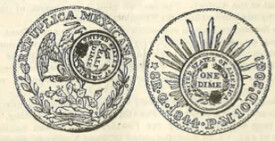 It is unclear how common this rather strange solution to the unstable currency situation was. At least one other specimen of similar
vintage is known to us, via a 1905 inquiry to the Numismatist. A dealer named B. P. Wright included the illustration ... in a letter
soliciting information about this unusual specimen. In this case the ‘host’ coin was an 1844 Mexican 8 reales, but the method and orientation of the
attached American coins suggests it was made by the same person. Editor George F. Heath responded as follows:
It is unclear how common this rather strange solution to the unstable currency situation was. At least one other specimen of similar
vintage is known to us, via a 1905 inquiry to the Numismatist. A dealer named B. P. Wright included the illustration ... in a letter
soliciting information about this unusual specimen. In this case the ‘host’ coin was an 1844 Mexican 8 reales, but the method and orientation of the
attached American coins suggests it was made by the same person. Editor George F. Heath responded as follows:
During this time (1871-79 ) we resided in the great southhwest. For a period of about fifteen years silver had been driven from circulation and was rarely seen, paper currency having almost entirely taken its place. Long about 1877 the banks in the section began the importation of Mexican dollars in great quantities which were eagerly taken up into circulation at par, but in the course of a couple of years silver had so fluctuated in value that the banks would only redeem them at eighty five cents. This was the condition of things in 1879. It must have been between 1877 and 1879 that the brilliant idea presented itself to the author of this combination of combining these coins in a substantial and permanent way. But it could not have been long after ere the piece which was partly bullion became entirely so, and became a fit subject for the curio portion of the numismatic cabinet.
If you have seen a similar piece, please do let us know!
To read the complete article, see:
MEXICAN-AMERICAN ‘DOLLAR,’ CIRCA 1877
(www.anspocketchange.org/mexican-american-dollar-circa-1877/)
GOOGLE TRANSLATE GOOFS
Google Translate is an excellent tool — it can translate 20 lines of text in 2 seconds. It can really handle a lot of the heavy lifting of translation English to Spanish. But it makes mistakes — and that is where you need a literate Spanish-speaking friend’s help. Here are some examples of that computer program taking numismatists from English to some very confused Spanish:
Mint: Menta — as in peppermint. No — it’s ceca or casa de la moneda.
Strike: Huelga — A strike yes — but by union members. No — its acuñar.
Date: Datil — Yes, that means date, the kind you eat. No—its fecha!
Cast: Elenco — That’s a cast of a movie or TV show. No — fundida.
Cob: Mazorca -- That’s Spanish for a corn cob! The word is macuquina.
Die: Muere — That means die — as in “Die, you dirty dog, die!”
Reeding: Caña – Means river reeds or cane. No, I need canto estriado here.

CENTS: TO SAVE OR NOT TO SAVE?
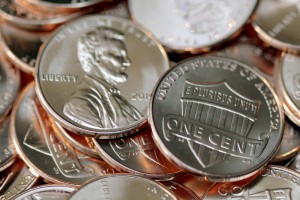 Nick Graver takes me to task this week. He has been saving cents and has a bag full. He writes: "This started a few years back, when
you were suggesting everyone store bags in expectation of their being more valuable when metal prices would change."
Nick Graver takes me to task this week. He has been saving cents and has a bag full. He writes: "This started a few years back, when
you were suggesting everyone store bags in expectation of their being more valuable when metal prices would change."
He listed these questions: "What is your current view on this topic? Just how much might they be worth if things went that way? Is it really worth the bother of storing bags?
His final statement "I cannot imagine these cents being valuable enough to be worth the effort."
I replied: The idea of increasing the value of a cent to a nickel was the concept -- which I endorsed -- of the staff economist of the Chicago Federal Reserve Bank, Francois Velde. This would solve several problems -- the rising cost of the metals in which cents were struck, the extreme low economic value of a cent, and if the cents were devalued or recalled, what would the country do with all that copper and zinc?
Velde's suggestion was brilliant. He called it rebasing the coin. Let it continue to circulated but at the higher value. If this happened your $50 bag of cents would be worth $250 in purchasing power. A nice windfall. But this would require a political action by the government. It appears the Treasury has no present desire to do this.
The treasury seems to prefer to continue sticking a cent despite the fact it cost the Mint nearly two cents to strike each cent.
To save or cash in your cents is up to you, Nick.
To read the earlier E-Sylum article, see:
DICK JOHNSON: WHY THE U.S. MINT SHOULD CEASE STRIKING CENTS
(www.coinbooks.org/esylum_v13n08a19.html)
IRELAND RETIRES 1- AND 2-CENT COINS

Ronnie O’Toole (left), Head of the Rounding Project, and former Member of Parliament for County Wexford, Ivan Yates (center), launch Ireland’s “Better All-Round” publicity campaign.
On October 28 , Ireland joined the likes of Belgium, Finland, and the Netherlands when they effectively removed their two smallest coins from general circulation. The practice of “rounding” up or down to the nearest five cents has been considered by many in the euro-zone, though just four of the current nineteen member states have put this into practice.
Finland was the first to do so after the adoption of the euro, as it was seen that these two coins were of little use in transactions within the Finnish economy. These coins are only being phased out of day-to-day transactions and remain legal tender that is exchangeable at banks and post offices for larger value coins. With any electronic purchase, the amount remains unaffected.
The question of what to do with very small denominations comes up periodically in many countries, especially in the United States, where the lowly one-cent piece actually costs twice the amount of its represented value to produce. The argument that nothing can be bought with a one-cent coin on either side of the Atlantic is a strong one. This logic, combined with manufacturing costs, prompted Canadians to discontinue the production and circulation of their one-cent coin last year.
Many in the U.S. have wondered how long it will take to see a similar decision from the Treasury and Federal Reserve. As we see a greater number of countries moving to lessen their coins in circulation, we’re also seeing an increase in developed economies moving toward cashless societies, in favor of technology-based and wireless payment methods.
On October 28, Ireland launched “All Round” day, meaning that any purchase price could be “rounded” up or down to the nearest five cents. Michael Alexander of the London Banknote and Monetary Research Centre spoke to Ronnie O’Toole, the Central Bank’s Head of the Rounding Project, to learn why the Irish have joined a few other countries in the euro-zone in ditching their small cents.
Michael Alexander (MA): I read about a trial project being launched last year in County Wexford to test the feasibility of eliminating these two coins from circulation. What were the conditions identified by the Bank that necessitated the idea?
Ronnie O’Toole (RO): Inflation has caused the purchasing power of 1 and 2-cent coins to diminish by over 20 per cent since their introduction. These coins are of little value individually, with essentially no goods or services priced at this level. Their primary function in the payments system is to make change for larger transactions and facilitate the exact settlement of debts.
The evidence suggests that 1- and 2-cent coins are not used actively by consumers and are expensive to mint. The large quantity of 1-cent coins issued annually, relative to existing stock, suggests that many of these coins are not actively circulated throughout the economy, but hoarded by consumers who do not like using them for transactional purposes, while others might simply be lost.
Research conducted for the Central Bank in 2012 suggested a strong desire on the part of both consumers and businesses in Ireland to reduce or discontinue the use of 1- and 2-cent coins. Furthermore, the production costs of 1-cent coins exceed their face value (unit cost of 1.65c), with the production costs of 2-cent coins being only slightly lower than their face value (unit cost of 1.94c).
MA: Was there any additional research the Central Bank carried out to arrive at this decision? Did they consider the example of Belgium, Finland, or the Netherlands, for instance, who also eliminated these two coins?
RO: The primary research carried out was the trial in Wexford. The Wexford Rounding Trial was run from September 16 to November 17, 2013, with the aim of reducing the need for 1- and 2-cent coins, and showed strong support for rounding, both from consumers and retailers. During the trial, retailers rounded change for cash transactions to the nearest 5 cents at the cash register, removing the need for 1- and 2-cent coins in change.
When “don’t knows” are excluded, 85% of consumers and 100% of retailers surveyed after the Trial believed rounding should be applied nationally. Following on the success of the Wexford Trial, in June of 2015 the government approved the national rollout of a voluntary rounding convention of amounts paid in cash nationally.
To read the complete article, see:
Ireland Retires 1-
and 2-cent Coins: A Q&A with Ronnie O’Toole of the Central Bank
(http://news.coinupdate.com/ireland-retires-one-and-two-cent-coins-a-qa-with-ronnie-otoole-of-the-central-bank/)
THE BOOK BAZARRE
GEORGIA ISSUES NEW BANKNOTES
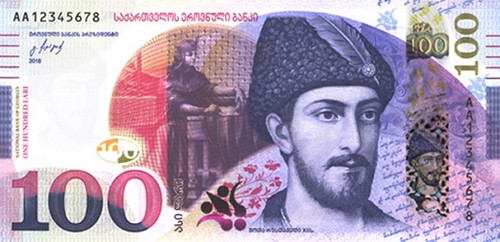
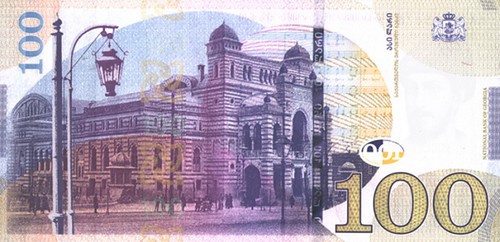
Georgia is changing the colour and size of its 20, 50 and 100 GEL banknotes.
From next year the new bills will be introduced into circulation alongside the existing currency. The new money will depict the same iconic faces but will have a vastly different and more vibrant look with additional elements.
The 20 GEL note will be a brighter red colour, the 50 GEL note will be green and the 100 GEL bill will have a deeper purple colour.
Today National Bank of Georgia (NBG) president Giorgi Kadagidze presented the new banknotes’ design at a special presentation. He said this was the first significant update of the banknotes in the past 20 years.
The renewed banknotes were better protected from fraudulent copying, and contained easily perceivable and modern signs that could even be recognised by people with visual impairments.
The new banknotes designer Bacha Malazonia has vast experience designing currency – he first designed Georgia’s national currency 20 years ago.
To read the complete article, see:
The colour of money: What do Georgia’s new banknotes look like?
(http://agenda.ge/news/45676/eng)
CAPE VERDE ISSUES NEW BANKNOTES

The new 500 and 5,000 escudo banknotes are already in circulation in Cape Verde, with the 200 escudo note honoring poet Jorge Barbosa (1902-1971) and the 5,000 escudo note featuring the country’s first president, Aristides Pereira (1923-2011).
The 500 escudo banknote also highlights the island of Santiago, the birthplace of Jorge Barbosa, a founder of the Claridade literary movement that marks a phase of contemporary aesthetics and language in Cape Verde and which called for cultural, social and political emancipation of society, bringing attention to the realities of daily life and whose poetry translates the archipelago’s problems and the social drama of the Cape Verdean people, in constant struggle with adversity due to drought, famine, emigration, isolation and insularity.
The 5,000 escudo banknote is also a tribute to the home of Aristides Pereira, Boa Vista Island, and depicts a landscape with the chimney of a pottery factory buried by sands in the foreground.
To read the complete article, see:
New banknotes come into circulation in
Cape Verde (www.cp-africa.com/2015/11/03/new-banknotes-come-into-circulation-in-cape-verde/)

RAINER FUCHS' ALTERED MYANMAR BANKNOTES


I read your item in the latest The E-Sylum: Myanmar Artist Incorporates Banknotes, with much interest because I just received a few days before it arrived some Burma/Myanmar banknotes that were altered with images of Sir Winston Churchill and Prince Charles. They were made by Rainer Fuchs and he also uses other world notes and has other people on them.
Being a collector of Burma/Myanmar numismatic pieces, I am really not in favor of altering a piece because it is one less piece for a collector to find who wants an unaltered piece. But Rainer is using very common notes, so maybe it is alright, and he sells them at very low prices. Maybe he can also do some special orders for your readers?
His mailing address is Talstrasse 82, D-88250 Weingarten, Germany, and his email address is info@stempelgeld.de.
To read the complete article, see:
MYANMAR ARTIST INCORPORATES BANKNOTES
(www.coinbooks.org/esylum_v18n44a40.html)

MOVIE MONEY SPENT IN TENNESSEE
 Police are investigating fake bills intended only for movie production that have found their way from Hollywood to Tennessee.
Police are investigating fake bills intended only for movie production that have found their way from Hollywood to Tennessee.
"Movie Money" is cash used by A-list actors in major motion pictures, that looks so real that it has been used as counterfeit money. Several merchants have accepted the fake $100 bills.
"It kind of caught me off-guard. They look so real if you don't read them it's easy to get taken," said Woodbury Police Chief Lowell Womak.
He said this was not a typical counterfeit case, with illegal bogus bills. They're actual movie props used in
"It says 'For Motion Picture Use Only' just across the top and on the back for 'Motion Picture Use Only,'" said Womak.
Ironically enough, the police station in Woodbury sits right next to the Moonlite Drive-In, and the evidence in the case was straight out of Hollywood.
"For $25.99 you can get $10,000," said Womak.
It's a deal like that that could only happen in a Hollywood script.
More thieves have started using the bills for counterfeit operations.
"They see this online and think let me order some of that; then they get it and it's real let me see if I can pass that," said Womack.
The money can seem so accurate that it has even fooled police. During production on one recent Hollywood movie, the fake money was so accurate police actually raided the set because some extras took the bills and spent them.
To read the complete article, see:
So-Called Movie
Money Turns Up In Tennessee Costing Merchants Cash
(/www.newschannel5.com/news/local-news/so-called-movie-money-turns-up-in-tennessee-costing-merchants-cash)
THE SILVER DOLLAR DRESS OF GREENVILLE, TX
Here's a link from eBay for a super cool cabinet card featuring a National bank and a dress made from currency.
To read the complete lot description, see:
Lady Advertising Greenville Tx. National Bank With Silver Dollar Dress -
1880's (www.ebay.com/itm/181915187663)
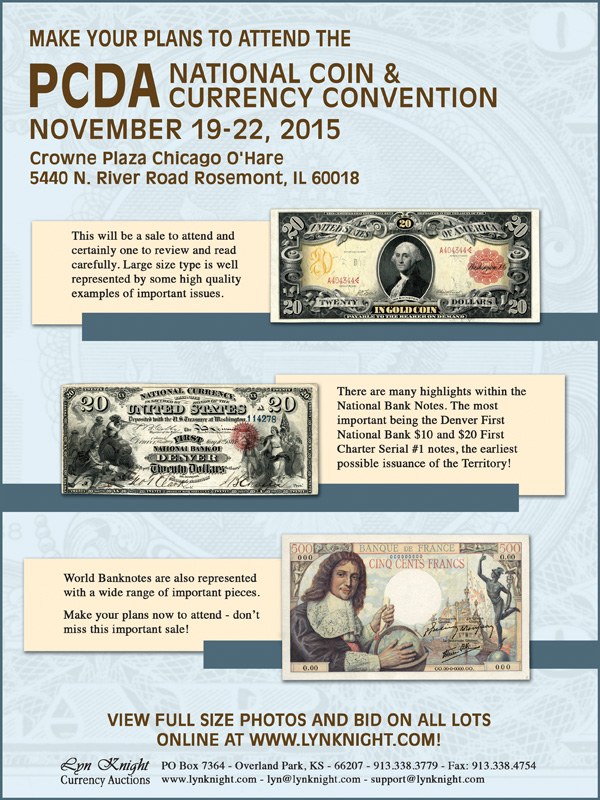
NUMISMATIC AUCTIONS SALE #58 CLOSES NOVEMBER 30, 2015
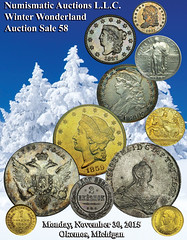 On Monday, November 30th, 2015 Steven L. Davis of Numismatic Auctions L.L.C. will be presenting his Rare Coin Auction Sale #58 in Okemos,
Michigan. The sale is comprised of nearly 1300 lots and features some notable collections and estates including some fantastic selections of Rare and
exotic Russian and European Coins from the Andrew Tuttle Memorial Museum of Defiance, Ohio; The Lake Elsinore Collection of Condition Census to
finest graded World Minor Coinage plus East and West Coast collections of US Proof and High Grade Type Coins, ICCS Graded Gem Canadian and Certified
World coins along with other fine consignments, unusual Tokens, Medals, Paper Money, Exonumia and more.
On Monday, November 30th, 2015 Steven L. Davis of Numismatic Auctions L.L.C. will be presenting his Rare Coin Auction Sale #58 in Okemos,
Michigan. The sale is comprised of nearly 1300 lots and features some notable collections and estates including some fantastic selections of Rare and
exotic Russian and European Coins from the Andrew Tuttle Memorial Museum of Defiance, Ohio; The Lake Elsinore Collection of Condition Census to
finest graded World Minor Coinage plus East and West Coast collections of US Proof and High Grade Type Coins, ICCS Graded Gem Canadian and Certified
World coins along with other fine consignments, unusual Tokens, Medals, Paper Money, Exonumia and more.
The sale can currently be viewed online in PDF format via clickable links in full color at www.numismaticauctionsllc.com on the Online Auction Listings page and published catalogs are available upon request by phone, text, mail or email. Steven can be contacted by phone or text at 517-394-4443 or by fax at 517-394-0579, his email address is numauctionsllc@aol.com and his mailing address is P.O. Box 22026, Lansing, MI 48909. The auction will take place at the Okemos Conference Center, 2187 University Park Drive, Okemos, MI 48864 on Monday, November 30th, 2015 on the heels of the MSNS Coin Convention in Warren, Michigan which is held on Thanksgiving weekend, November 27-29th. Lots are available for viewing on Friday and Saturday, November 27 & 28 at the MSNS Coin Convention and in Steve's office by appointment - no lot viewing will take place the day of the auction and Session One begins at 9:30AM, be sure to arrive early to register, no credit card purchases and checks are subject to hold prior to delivery of material to new customers.
Steven L. Davis
Numismatic Auctions L.L.C.
P.O. Box 22026
Lansing, MI 48909
USA
www.numismaticauctionsllc.com
Phone: 517-394-4443
Fax: 517-394-0579
Email: numauctionsllc@aol.com
Lot 48: 1864. Copper-Nickel Indian Head Cent

Lot 81: 1914-D. Key date Lincoln Cent
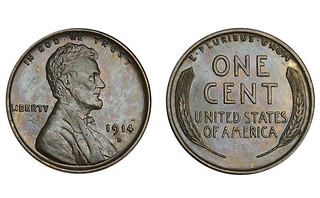
Lot 106: 1831 Capped Bust Half Dime

Lot 213: 1877 Quarter Key date Proof only issue
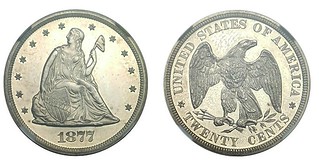
Lot 214: 1815 Capped Bust Quarter B-1. “E” countermark at 12 o’clock obverse.
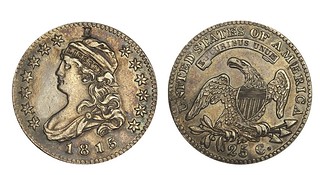
Lot 216: 1821 Quarter

Lot 256: 1916 Standing Liberty Quarter

Lot 258: 1917 Standing Liberty Quarter

Lot 286: 1815/12. Half Dollar Overdate Rarity O-101.

Lot 321: 1869 Seated Half Dollar

Lot 331: 1884 Seated Half Dollar
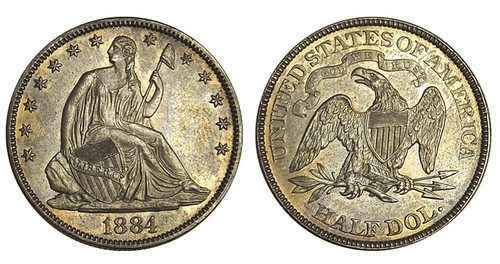
Lot 376: 1867 Dollar
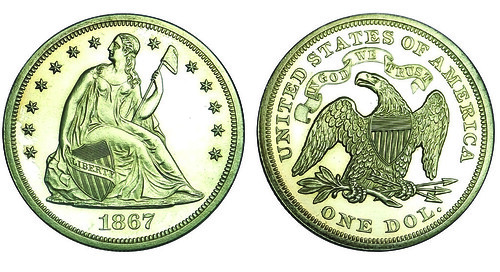
Lot 417: 1893 Morgan Dollar Semi-key date
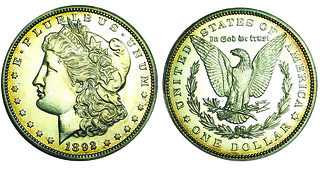
Lot 472: 1859 Double Eagle
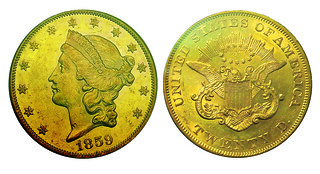
Lot 699: Liechtenstein 1728 Taler

Joseph Johann Adam, 1721-1732. Taler, 1728. Dav. 1578, KM- 2. Beautiful pastel blue and pale gold AU to Choice AU, semiprooflike fields. Rarely offered, let alone this nice. Only 810 struck!
Lot 709: Luxembourg 1889 5 Francs Essai
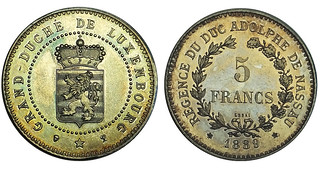
Essai Silver 5 Francs, 1889. KM-E20. Pastel gold and blue toned Proof/Specimen, some minor clouding and tiny inclusions, ticks and a few random hairlines. Quite scarce and very desirable. Ex: Jacques Schulman, March 18, 1963.
Lot 715: Russia 1654 Novodel Rouble
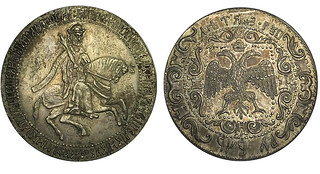
Novodel Jefimok Rouble (1654). Silver. Reichel-715. Tsar on horseback with scepter; Rx: Imperial double-headed eagle. Toned AU. A pleasing example of this seldom offered Novodel of the rare first crown of Russia. Ex: Coin Galleries, c. 1950’s.
Lot 719: Russia 1702 Possible Novodel,
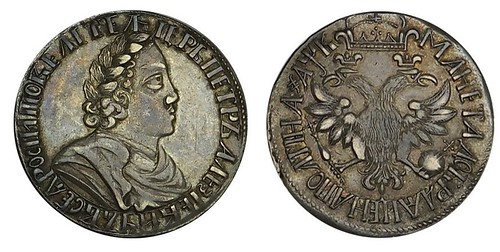
Poltina, 1702. Possible Novodel, similar to Bit-515, Diakov-3. Toned Choice VF-EF. Rarely offered, an example for the specialist. This coin is sure to enlist some competitive bidding. Ex: Randolph Zander.
Lot 740: Russia 1757 96 Kopecks
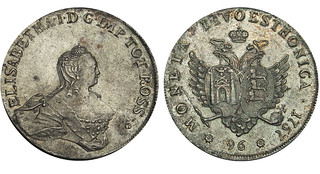
96 Kopecks (Rouble), 1757. Struck for Livonia & Estonia. Dav. 1650, KM-5. AU for issue with underlying luster, rare grade. Rarely encountered this nice. Ex: Abner Kreisberg.
Lot 742: Russia Peter III Taler
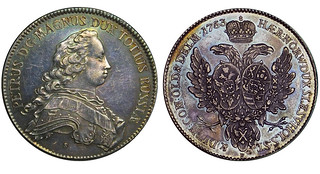
Albertus Taler, 1753-S. Peter III as Duke of the German State Schleswig-Holstein-Gottorp. Dav. 1353, KM-226.1. Beautifully toned teal, gold and steel blue AU, reflective prooflike fields exhibit some stray underlying hairlines and lt contact. Ex: Randolph Zander.
Lot 749: Russia 1796 Albertus Rouble
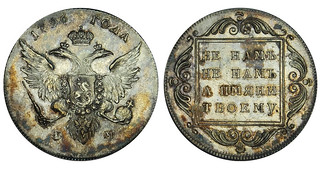
Albertus Rouble, 1796. St. Petersburg. KM-Pn46. Pastel gold to blue-grey toned Specimen, Borderline Unc to Unc, reflective fields, a few stray old marks and hairlines. Ex: Randolph Zander.
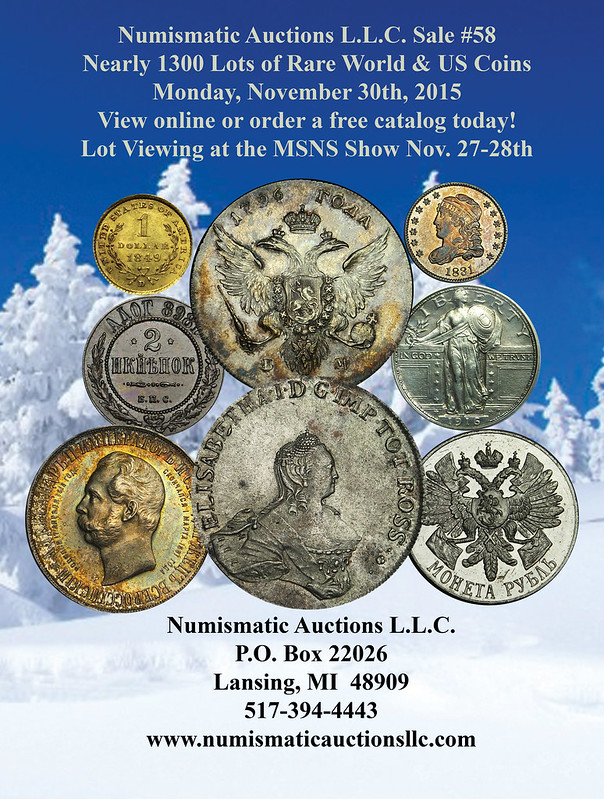
TRICK OR TREAT: COIN OR CANDY?
Last year the breakdown was 50/50 (300+ total), candy bars/coins, this year 71/29 (229 total). It was surprising to me as the coins were better, maybe each worth 40 to 50 candy bars (except the small bronzes).
32 Severan (or therabouts) provincial bronzes
29 Imperial denarii
5 Constantine (or therabouts) small bronzes
66 total
We pushed the coins more last year "1600 year old Roman coin ..." as opposed to "Roman coin", I was more neutral presenting the choice. Next year I'll be more informative about the coins and have a handout in case anyone wants it.
Some of the comments were priceless, however, for example -
One father: "I bet there is no Tiberius in there" (Vespasian/Domitian/Marcus Aurelias/others - many of them women)
One mother: "This should be an experiment ... but of course that's what you are doing"
Two separate sets of teenagers to one another when walking away: "Awesome"
Another teenager: "I got the coin last year" (she took the candy this time)
ATM MAKER EXPERIMENTING WITH RETINA SCANNER
 Spy movies and high-tech science fiction tales have introduced us all to the “retinal scan” – a form of identification that requires a
match to the pattern of a person’s retina blood vessels. This is somewhat similar to an “iris scan,” also known as iris recognition, which uses
pattern-recognition to identify the random patterns of unique irises. In either case, most people wandering the streets do not use retinal or iris
scanners on a day-to-day basis. If we need to identify ourselves, we use a driver’s license, or passport, or student ID card. But that could be
changing in regards to banking and ATMs.
Spy movies and high-tech science fiction tales have introduced us all to the “retinal scan” – a form of identification that requires a
match to the pattern of a person’s retina blood vessels. This is somewhat similar to an “iris scan,” also known as iris recognition, which uses
pattern-recognition to identify the random patterns of unique irises. In either case, most people wandering the streets do not use retinal or iris
scanners on a day-to-day basis. If we need to identify ourselves, we use a driver’s license, or passport, or student ID card. But that could be
changing in regards to banking and ATMs.
Last week, Citigroup, partnered with Diebold (a company that designs ATMs), introduced the “Irving model” ATM for testing in New York. The new machine was simultaneously showcased at a financial services trade show in Las Vegas. This model ATM will identify users by scanning their eyes with iris recognition before dispensing cash to the user. The process is supposed to take about 10 seconds and will reduce the need for screens, card readers, and touch pads; it will also take up less space and time.
If the testing in New York proves successful, the day-to-day use of biotechnology could be less than a decade away. Richard Harris, the vice president of new technology, incubation, and design for Diebold, says that “I think in five years or so, the idea of carrying a card, or frankly, even carrying a mobile device will be obsolete. You’ll just have to present yourself via eye scan or a fingerprint scan, and that will be it. You’ll be able to access that data without the phone or without the card.”
To read the complete article, see:
The Future Is Now (http://news.coinupdate.com/the-future-is-now/)
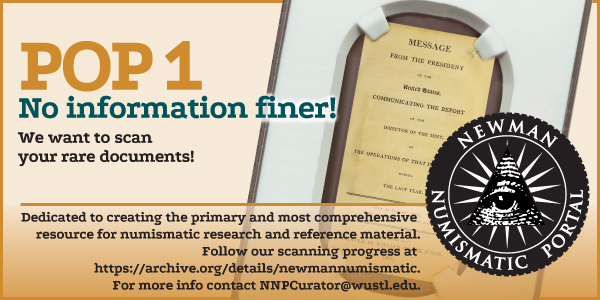
FEATURED WEB SITE: CORPUS NUMMORUM THRACORUM
This week's Featured Web Site is Corpus Nummorum Thracorum, a web site for researchers interested in the ancient coins of Thrace. Thanks to this week'sCoinsWeekly for mentioning the site.The web portal Corpus Nummorum Thracorum offers a platform to find and research Thracian coins. It is based on collections found in Berlin, but it is growing by incorporating coins from other museums and institutions world wide. Users can also add to the collection by entering their own Thracian coins into the web portal

www.corpus-nummorum.eu

